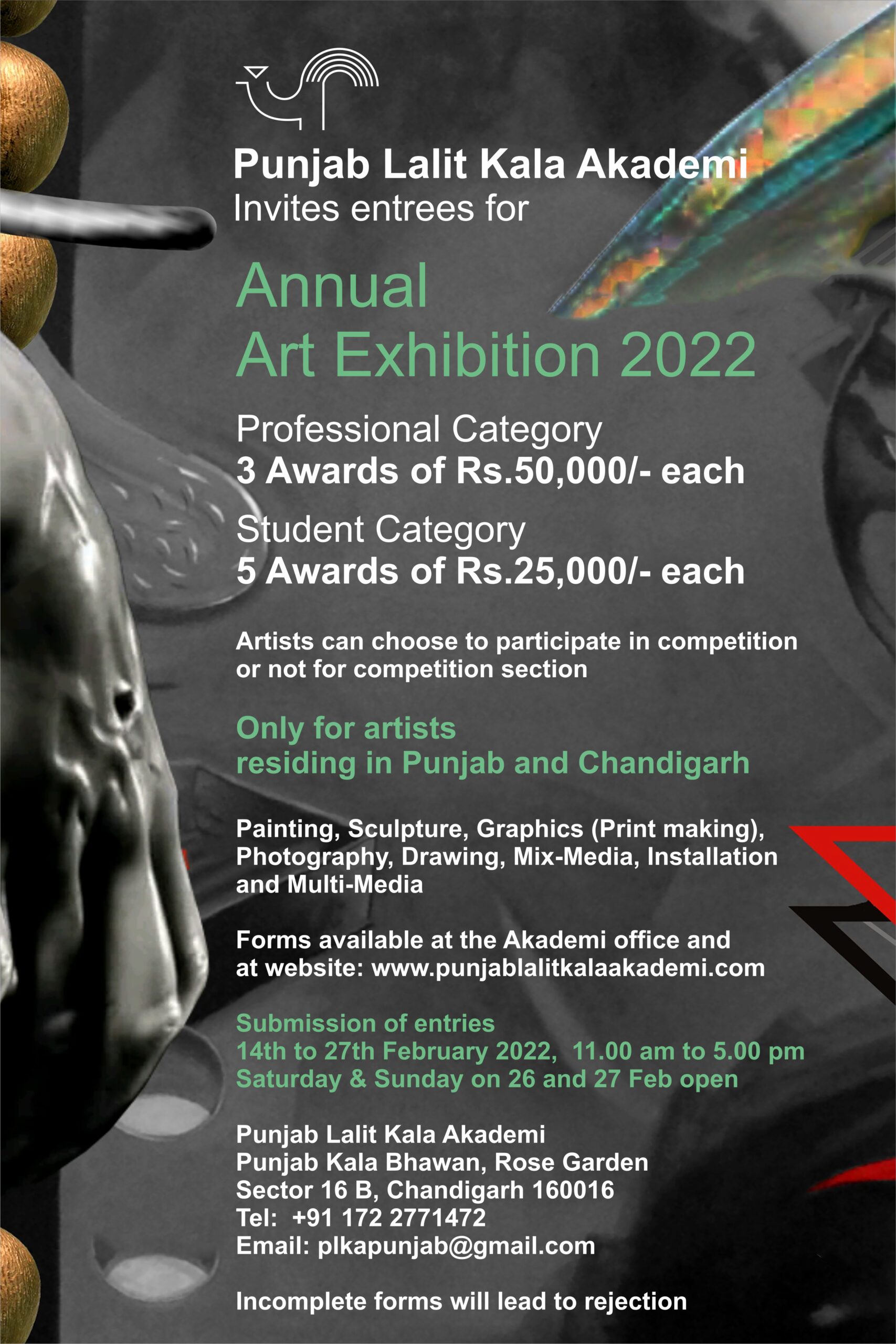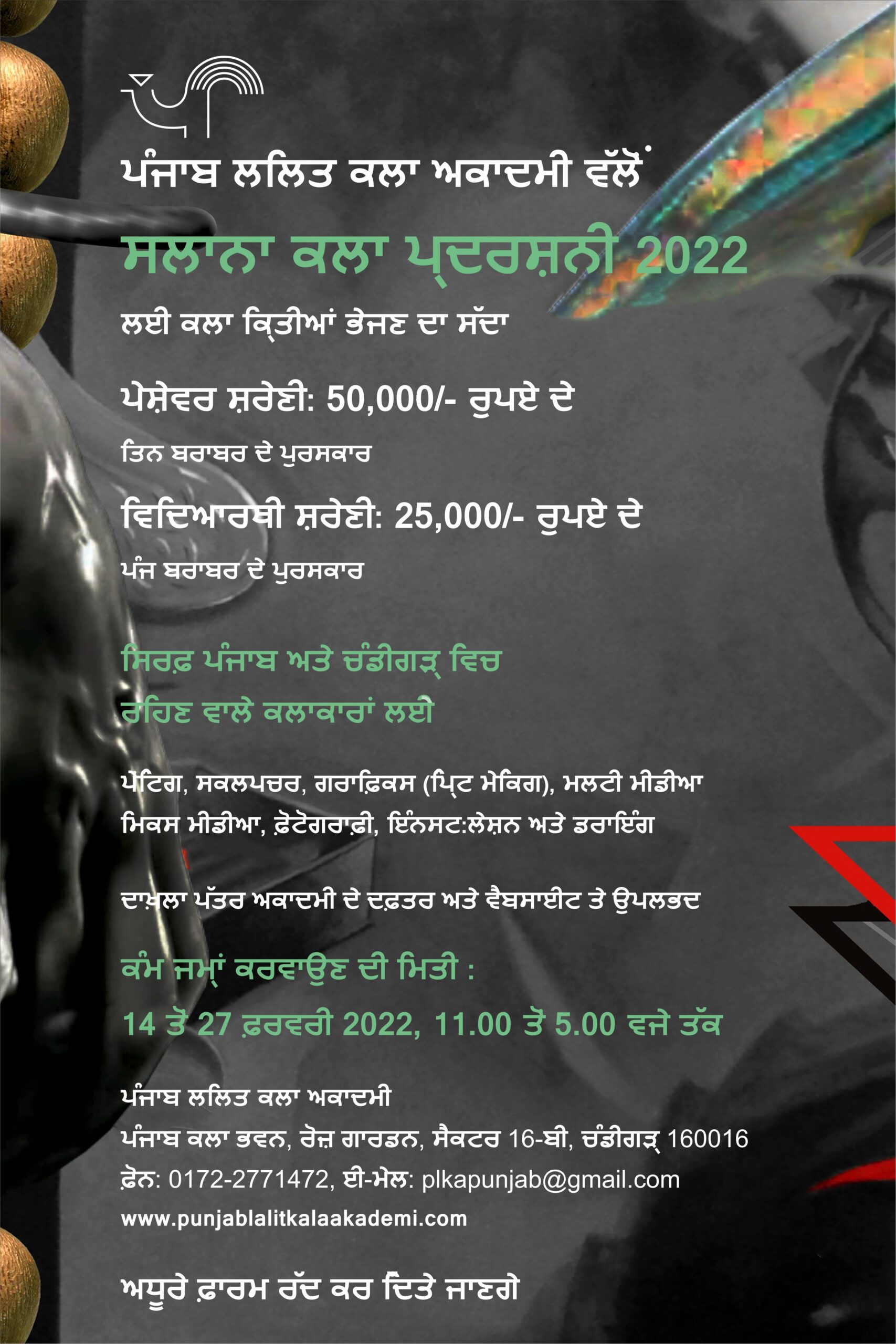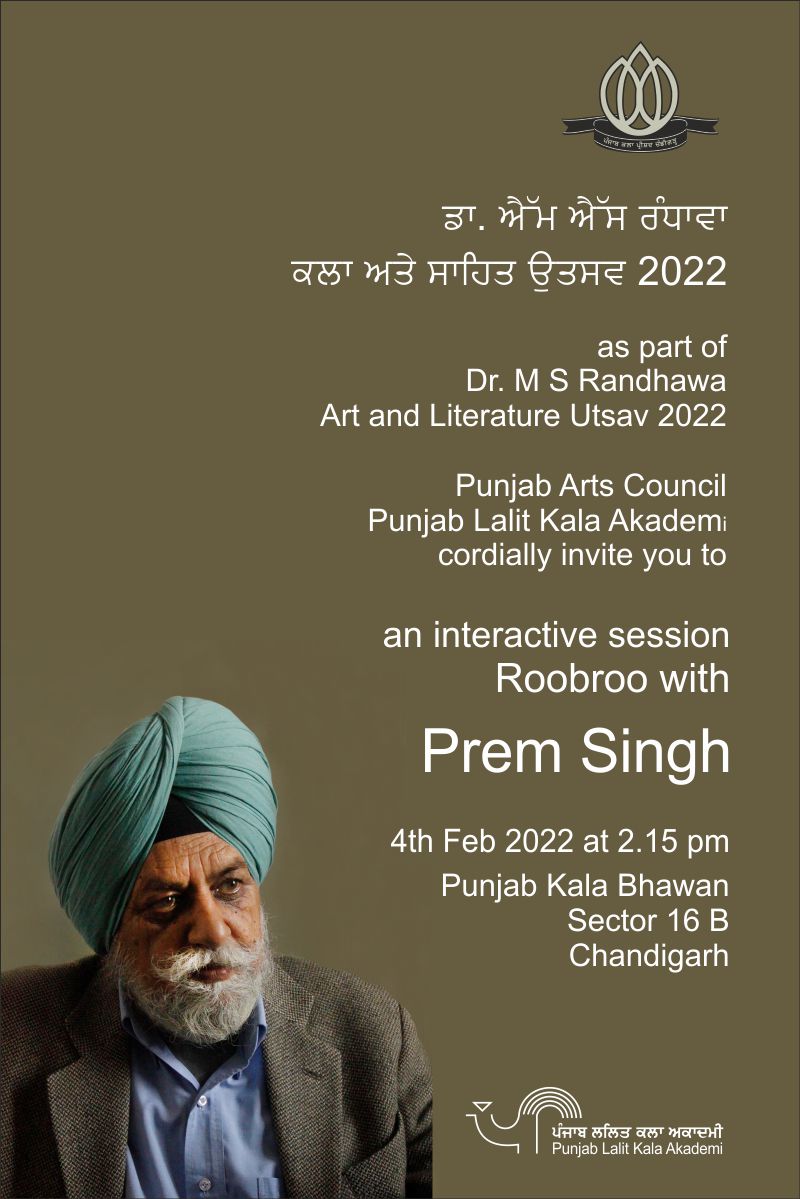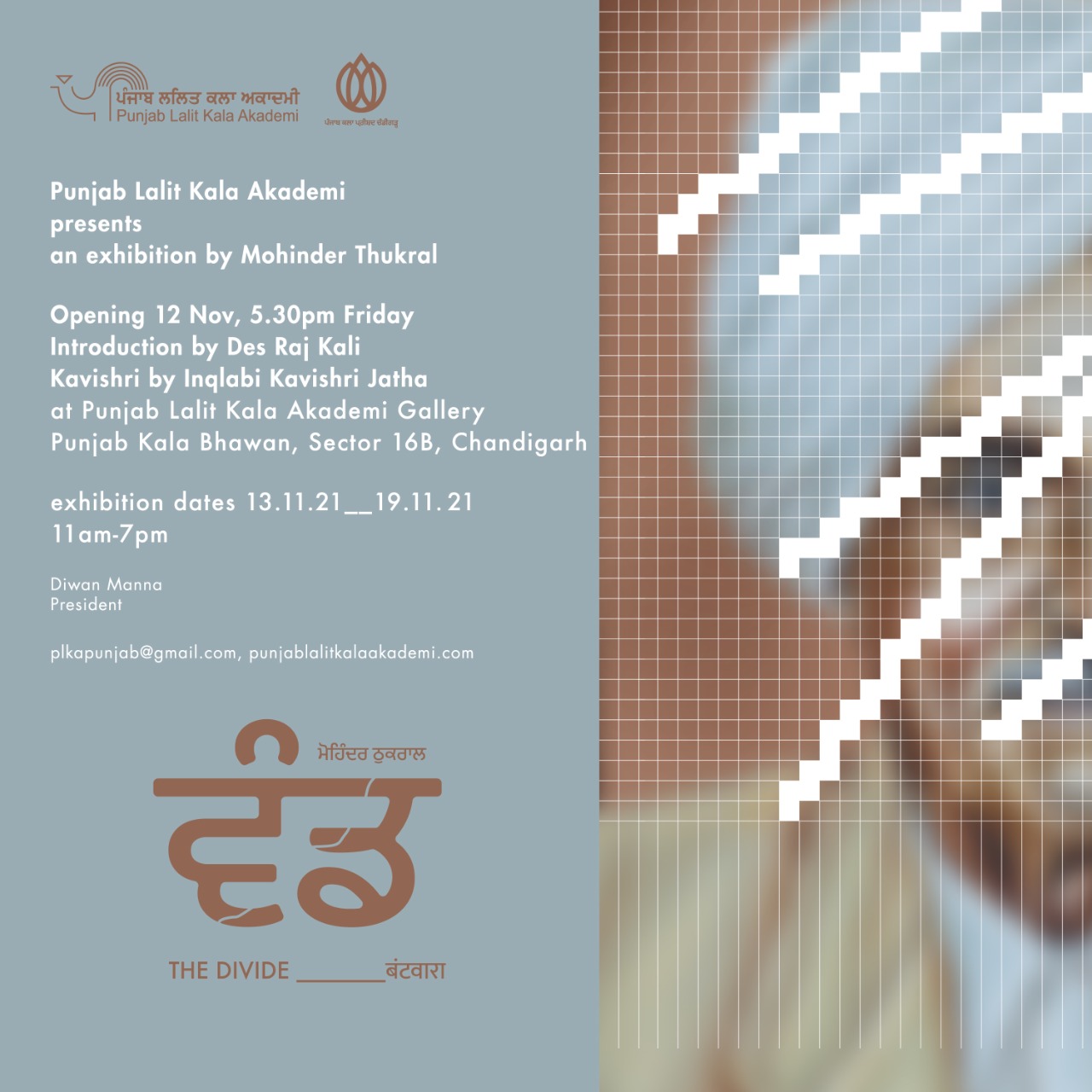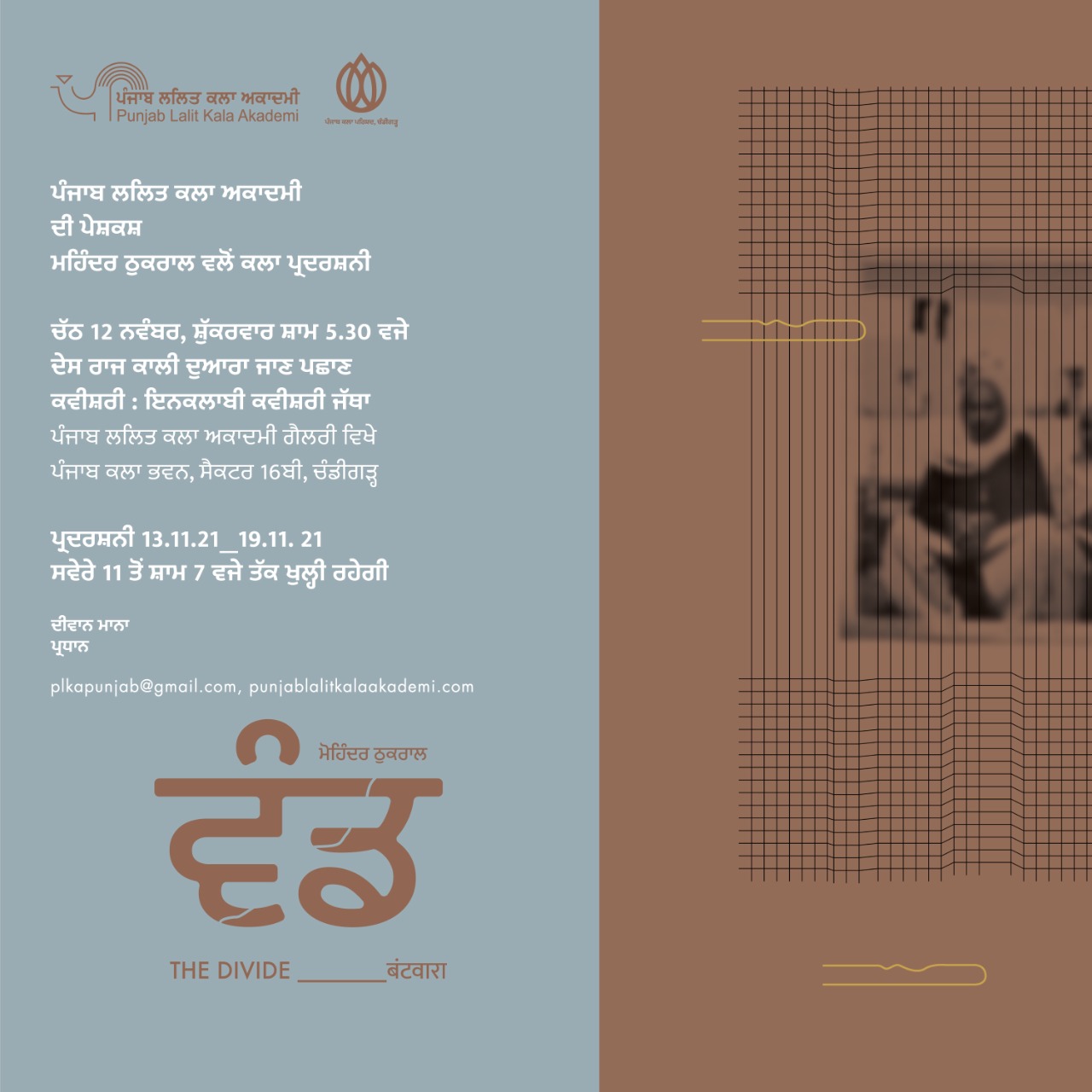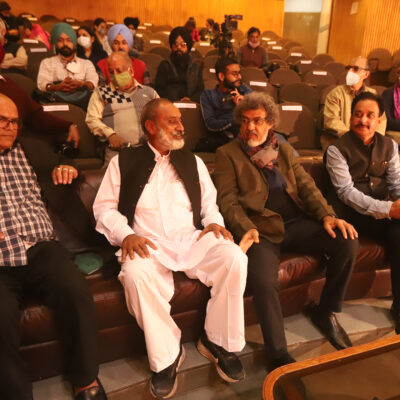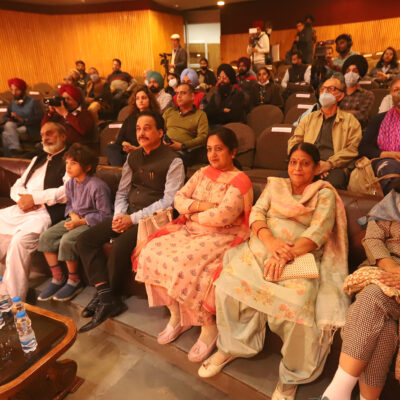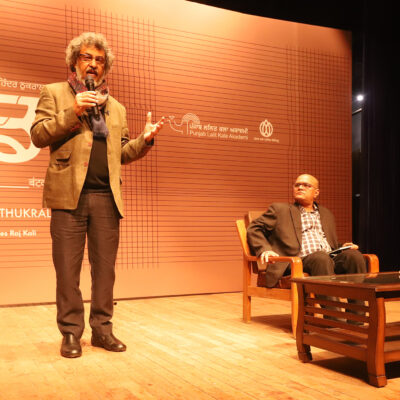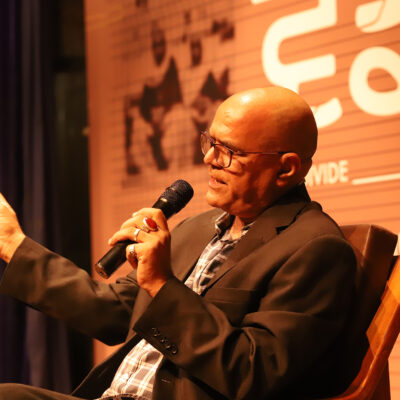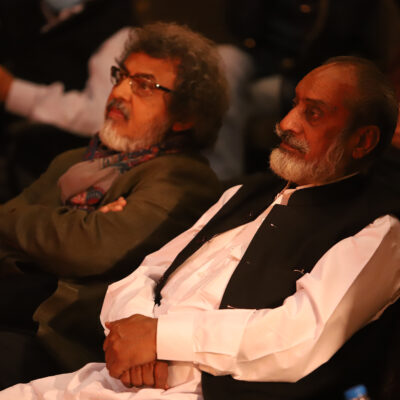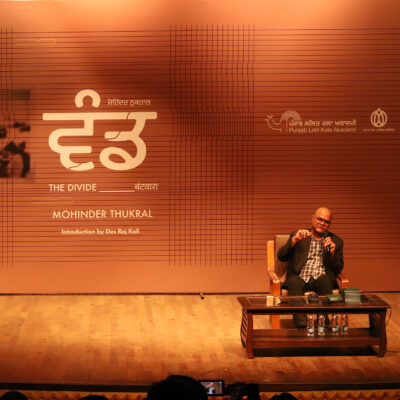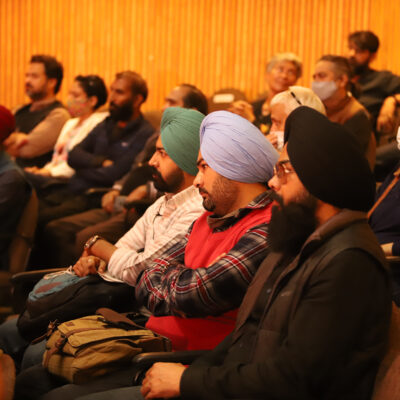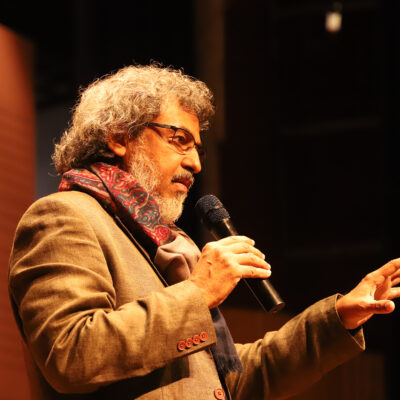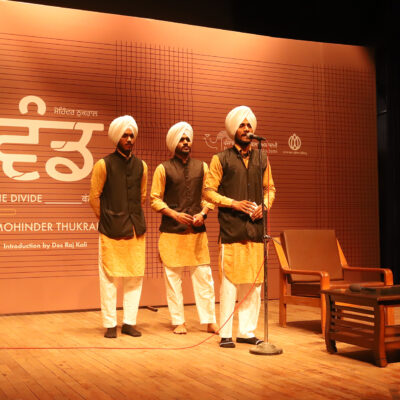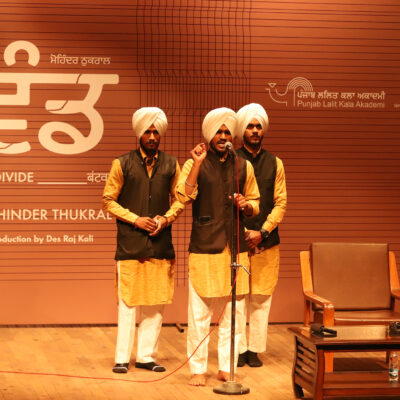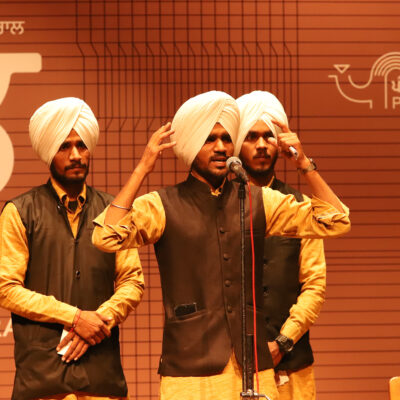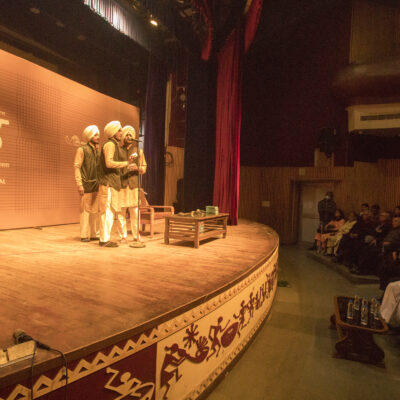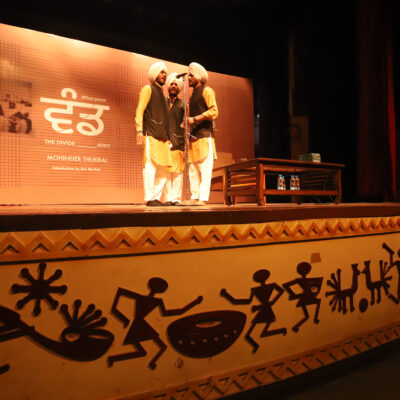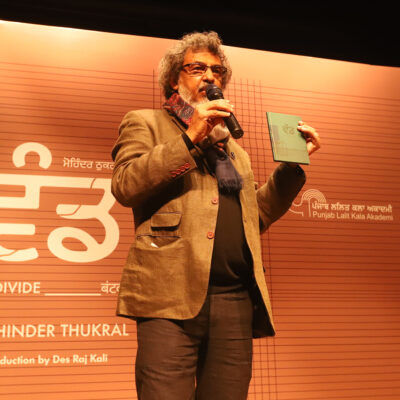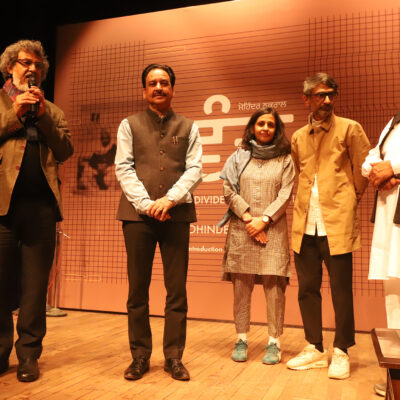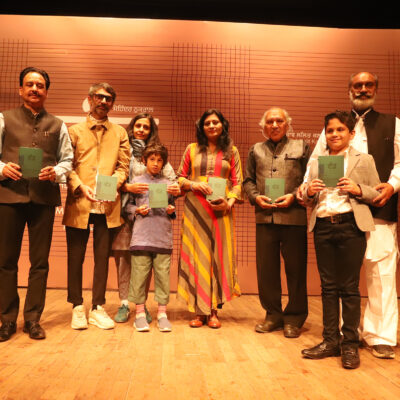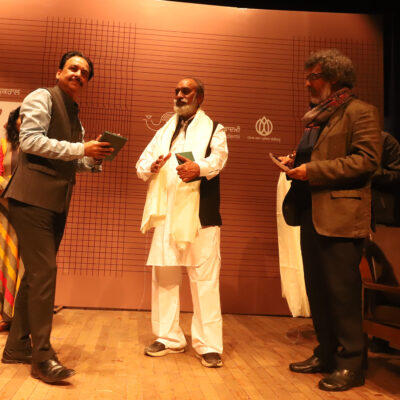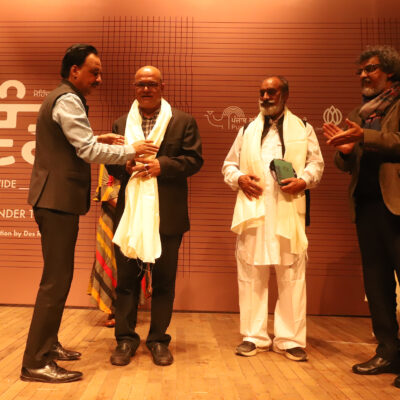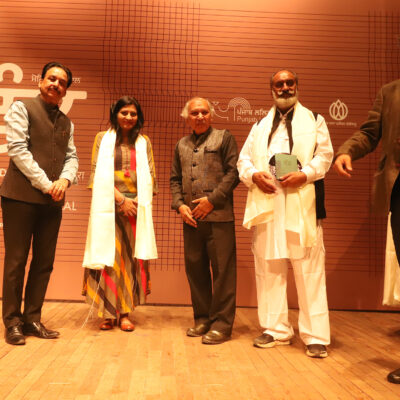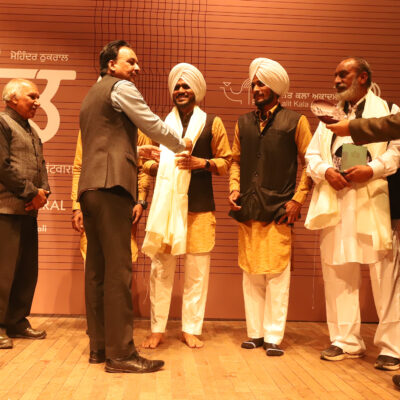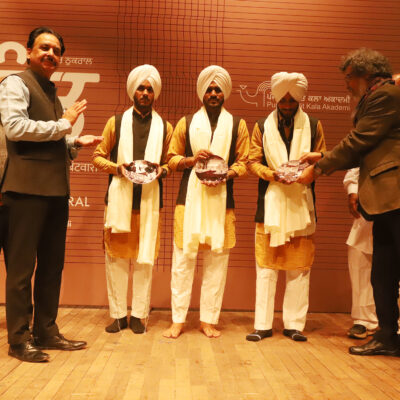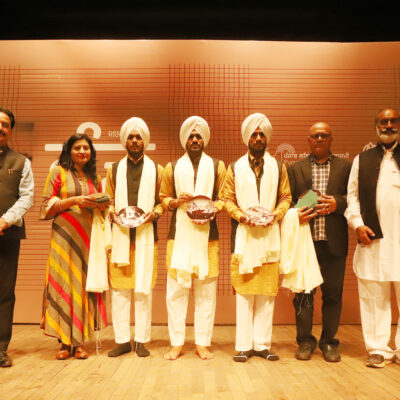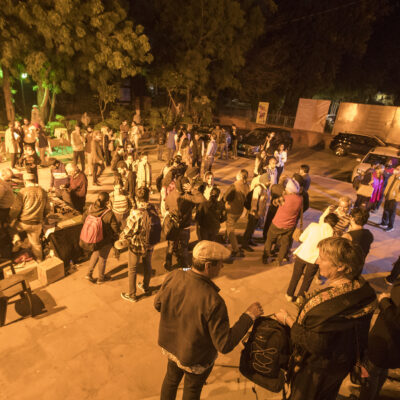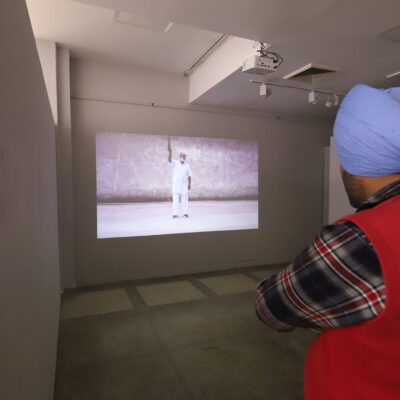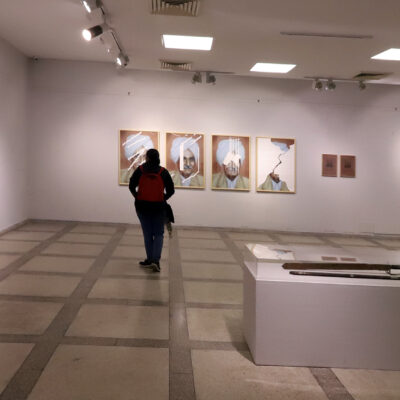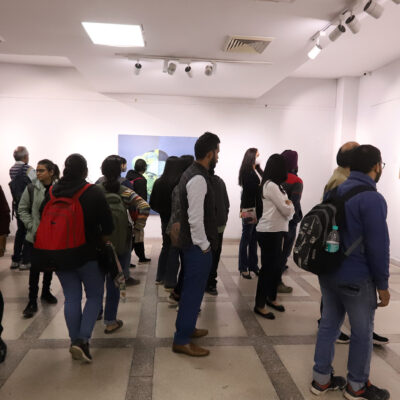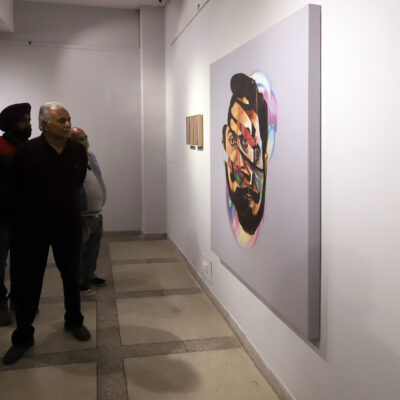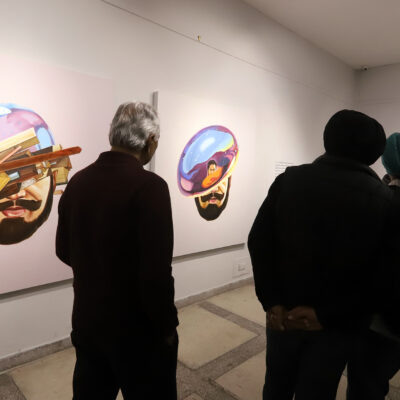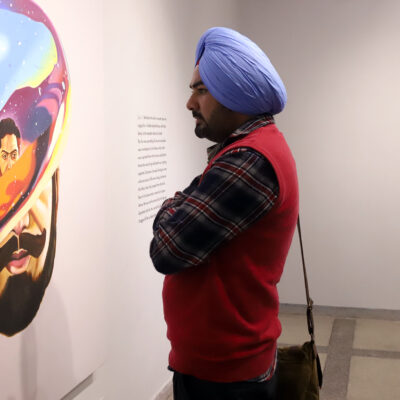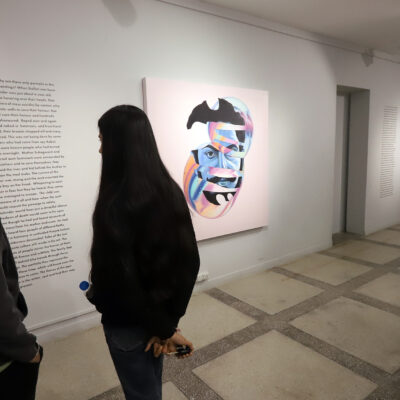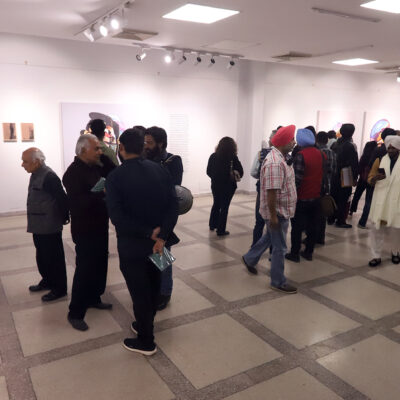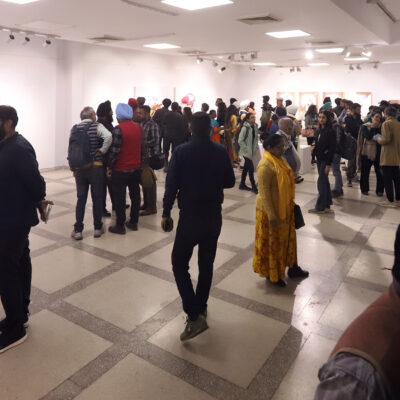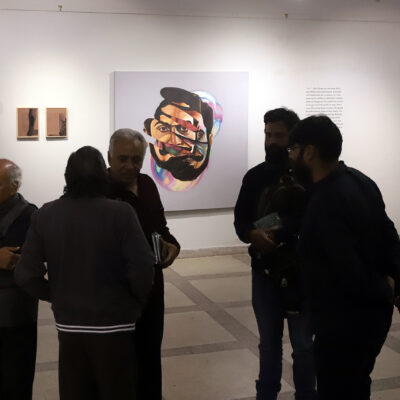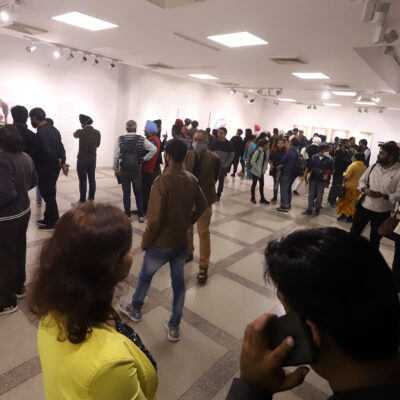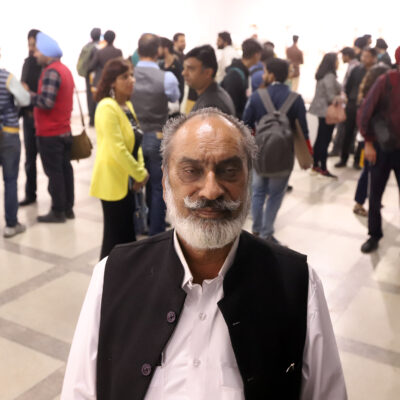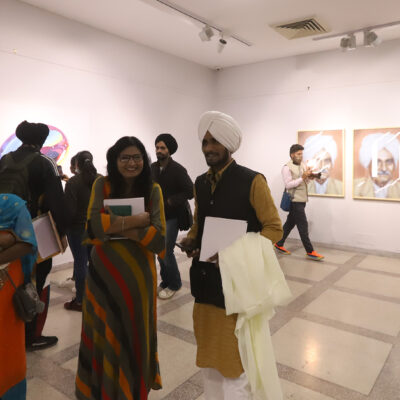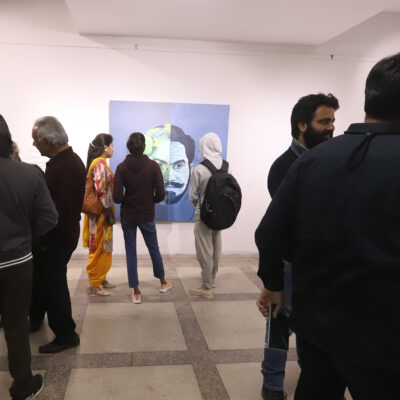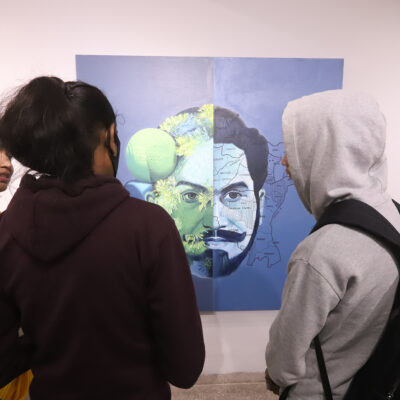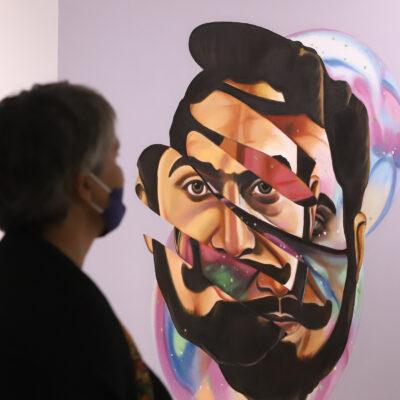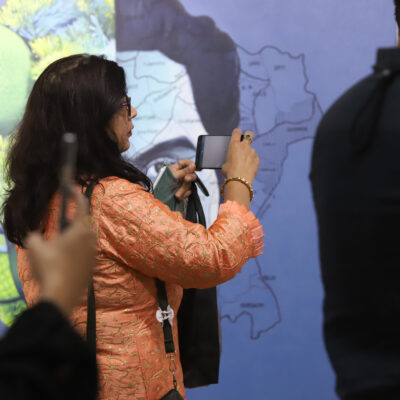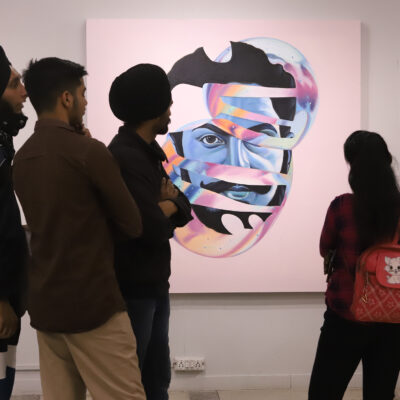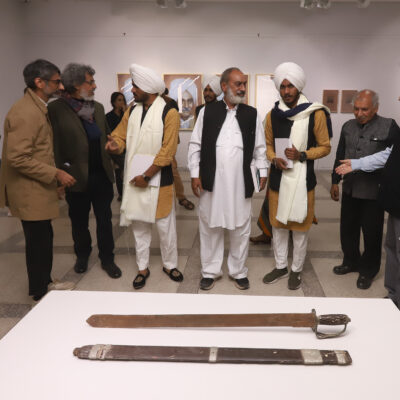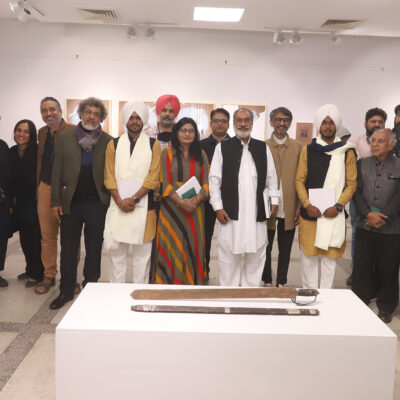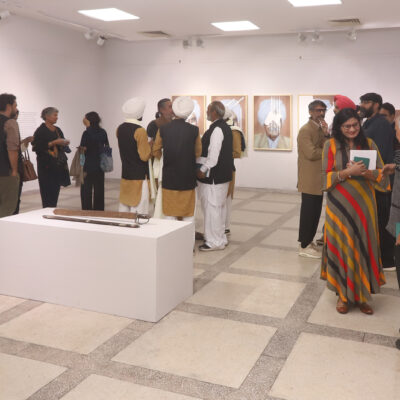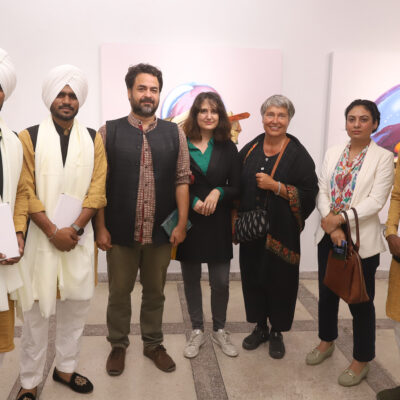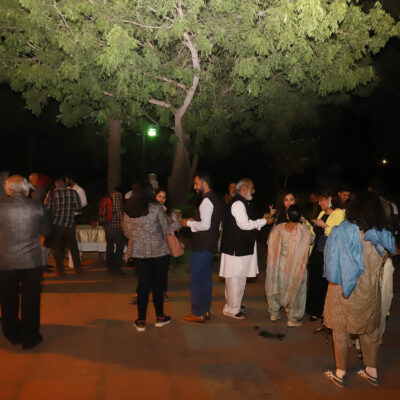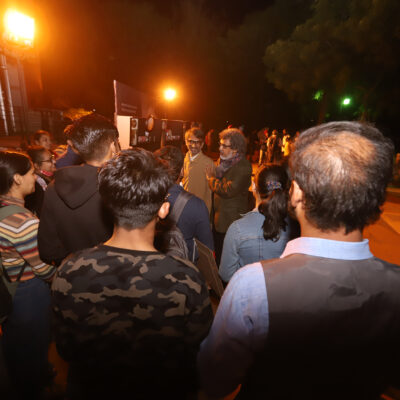-
Mon14Feb2022Sun27Feb2022
Applications/Entrees Invited for Annual Art Exhibition 2022 / ਸਲਾਨਾ ਕਲਾ ਪ੍ਰਦਰਸ਼ਨੀ 2022 ਲਈ ਕਲਾ ਕ੍ਰਿਤੀਆਂ ਭੇਜਣ ਦਾ ਸੱਦਾ -11.00 am to 5.00 pm
Punjab Lalit Kala Akademi
Invites entrees for
Annual
Art Exhibition 2022
Professional Category
3 Awards of Rs.50,000/- each
Student Category
5 Awards of Rs.25,000/- each
Artists can choose to participate in competition
or not for competition section
Only for artists
residing in Punjab and Chandigarh
Painting, Sculpture, Graphics (Print making),
Photography, Drawing, Mix-Media, Installation
and Multi-Media
Forms available at the Akademi office and
at website: www.punjablalitkalaakademi.com
Submission of entries
14th to 27th February 2022, 11.00 am to 5.00 pm
Saturday & Sunday on 26 and 27 Feb open
Punjab Lalit Kala Akademi
Punjab Kala Bhawan, Rose Garden
Sector 16 B, Chandigarh 160016
Tel: +91 172 2771472
Email: [email protected]
Incomplete forms will lead to rejection
ਪੰਜਾਬ ਲਲਿਤ ਕਲਾ ਅਕਾਦਮੀ ਵੱਲੋਂ
ਸਲਾਨਾ ਕਲਾ ਪ੍ਰਦਰਸ਼ਨੀ 2022
ਲਈ ਕਲਾ ਕ੍ਰਿਤੀਆਂ ਭੇਜਣ ਦਾ ਸੱਦਾ
ਪੇਸ਼ੇਵਰ ਸ਼੍ਰੇਣੀ : 50,000/- ਰੁਪਏ ਦੇ
ਤਿੰਨ ਬਰਾਬਰ ਦੇ ਪੁਰਸਕਾਰ
ਵਿਦਿਆਰਥੀ ਸ਼੍ਰੇਣੀ: 25,000/- ਰੁਪਏ ਦੇ
ਪੰਜ ਬਰਾਬਰ ਦੇ ਪੁਰਸਕਾਰ
ਸਿਰਫ਼ ਪੰਜਾਬ ਅਤੇ ਚੰਡੀਗੜ੍ਹ ਵਿਚ ਰਹਿਣ ਵਾਲੇ ਕਲਾਕਾਰਾਂ ਲਈ
ਪੇਂਟਿੰਗ, ਸਕਲਪਚਰ, ਗ੍ਰਾਫ਼ਿਕਸ (ਪ੍ਰਿੰਟ ਮੇਕਿੰਗ), ਮਲਟੀ ਮੀਡੀਆ,
ਮਿਕਸ ਮੀਡੀਆ, ਫੋਟੋਗਰਾਫ਼ੀ, ਇੰਸਟ:ਲੇਸ਼ਨ, ਅਤੇ ਡਰਾਇੰਗ
ਦਾਖ਼ਲਾ ਪੱਤਰ ਅਕਾਦਮੀ ਦੇ ਦਫ਼ਤਰ ਅਤੇ ਵੈਬਸਾਈਟ 'ਤੇ ਉਪਲਭਦ
ਕੰਮ ਜਮ੍ਹਾਂ ਕਰਵਾਉਣ ਦੀ ਮਿਤੀ : 14 ਤੋਂ 27 ਫ਼ਰਵਰੀ 2022
ਸਵੇਰ 11.00 ਤੋਂ ਸ਼ਾਮ 5.00 ਵਜੇ ਤੱਕ
ਪੰਜਾਬ ਲਲਿਤ ਕਲਾ ਅਕਾਦਮੀ, ਪੰਜਾਬ ਕਲਾ ਭਵਨ,
ਰੋਜ਼ ਗਾਰਡਨ, ਸੈਕਟਰ, 16 ਬੀ, ਚੰਡੀਗੜ੍ਹ 160015
ਫ਼ੋਨ: +91 (0)172 2771472
ਈ-ਮੇਲ: [email protected]
www.punjablalitkalaakademi.com
ਅਧੂਰੇ ਫ਼ਾਰਮ ਰੱਦ ਕਰ ਦਿੱਤੇ ਜਾਣਗੇ
ਪੋਸਟਰ ਵਿਚਲੀ ਪੇਂਟਿੰਗ: ਜਸਪਾਲ ਐੱਸ ਦੀ ਪੇਂਟਿੰਗ ਵਿਚੋਂ ਇੱਕ ਹਿੱਸਾ ਕੁੱਝ ਤਬਦੀਲੀ ਕਰਨ ਤੋਂ ਬਾਅਦ ਵਰਤਿਆ ਗਿਆ ਹੈ
-
Fri04Feb2022
-
Fri12Nov2021Fri19Nov2021
ਵੰਡ -THE DIVIDE - बंटवारा An Exhibition of Paintings by Mohinder Thukral -opening on 12th at 5.30 pm other days11 am to 7.00 pm
ਵੰਡ
ਪੰਜਾਬ ਲਲਿਤ ਕਲਾ ਅਕਾਦਮੀ ਦੀ ਪੇਸ਼ਕਸ਼
ਮੋਹਿੰਦਰ ਠੁਕਰਾਲ ਵੱਲੋਂ ਕਲਾ ਪ੍ਰਦਰਸ਼ਨੀ
ਚੱਠ: ੧੨ ਨਵੰਬਰ, ਸ਼ੁੱਕਰਵਾਰ ਸ਼ਾਮ ੫.੩੦ ਵਜੇ
ਦੇਸ ਰਾਜ ਕਾਲੀ ਦੁਆਰਾ ਜਾਣ-ਪਛਾਣ
ਕਵੀਸ਼ਰੀ : ਇਨਕਲਾਬੀ ਕਵੀਸ਼ਰੀ ਜੱਥਾ
ਪੰਜਾਬ ਲਲਿਤ ਕਲਾ ਅਕਾਦਮੀ ਦੀ ਗੈਲਰੀ ਵਿਖੇ
ਪੰਜਾਬ ਕਲਾ ਭਵਨ, ਸੈਕਟਰ ੧੬ ਬੀ, ਚੰਡੀਗੜ੍ਹ, ਭਾਰਤ
ਪ੍ਰਦਰਸ਼ਨੀ ੧੩ ਤੋਂ ੧੯ ਨਵੰਬਰ ੨੦੨੧ ਤੱਕ
ਸਵੇਰੇ ੧੧.00 ਤੋਂ ਸ਼ਾਮ ੭.00 ਵਜੇ ਤੱਕ ਖੁਲ੍ਹੀ ਰਹੇਗੀ
ਦੀਵਾਨ ਮਾਨਾ, ਪ੍ਰਧਾਨ
THE DIVIDE ਵੰਡ
Punjab Lalit Kala Akadmi Presents
Exhibition of paintings by
Mohinder Thukral
Opening on 12th November 2021-11-06 at 5.30 pm
Introduction: Des Raj Kali
Kavishri: Inqlabi Kavishri Jattha
Punjab Lalit Kala Akademi Gallery
Punjab Kala Bahwan, Sector 16 B, Chandigarh 160015, India
Diwan Manna
President
W: punjablalitkalaakademi.com
---------------------------------------------------------------
Foreword
This exhibition by Mohinder Thukral is an endeavor not only to remind us of the horrors and sufferings of millions but also to help in understanding the intricate and complicated web of thought processes that prompted friends, acquaintances and neighbours, who had co-existed in peace and goodwill for centuries, to become the part of frenzied mobs out to loot, rape and kill. What was it that turned humans into blood-thirsty beasts?
Mohinder Thukral was only a year old at the time of Partition and heard these stories from his mother and her sister and later from his grandfather. Although he lived his life well as a wrestler and a commercial artist painting billboards for the mainstream Hindi Cinema of which his brother was a distributor in Jalandhar, yet throbbing memories and pangs of suffering never let him rest at peace. His inner voice was pulsating to find expression as the artist residing in the dark alleys yearned to translate those memories into visuals on canvas.
Now when Mohinder is almost 76, he resolved to hear that inner voice and what we see is a very powerful set of images that, in my view, would help us look at the haunting past with a new perspective.
Seventy-five years after the bloodbath that shook the conscience of the helpless and the humane, on both sides of the dividing line, there is still a stab in the heart. Silence became the surviving tool and the wounds were kept guarded. Many among the generations to follow remained unaware of the wages of freedom that were paid that side and this side as the Radcliffe line mercilessly divided the nation into two on the basis of religion. One may say that it is best that the ghosts of the past be banished yet for the sake of better understanding of the how and why of what happened, it becomes essential to have a considered review that finds expression in art, poetry, music and other creative modes, every now and then.
With the organisation of this exhibition the Akademi intends to contribute in the continuation of a dialogue by revisiting the wounds of the unpleasant past not to hurt but to find means to heal them in the hope of a beautiful and pleasant future.
-Diwan Manna
Artist and President, Punjab Lalit Kala Akademi
ਮੁਖਬੰਧ
ਮੋਹਿੰਦਰ ਠੁਕਰਾਲ ਦੀ ਪ੍ਰਦਰਸ਼ਨੀ ‘ਵੰਡ' ਲੱਖਾਂ ਲੋਕਾਂ ਨੂੰ ਡਰ-ਭੈਅ ਅਤੇ ਦੁੱਖ-ਤਕਲੀਫ਼ਾਂ ਦੀ ਹੀ ਯਾਦ ਕਰਾਉਣ ਦੀ ਕੋਸ਼ਿਸ਼ ਨਹੀਂ, ਸਗੋਂ ਉਸ ਸੋਚ ਪ੍ਰਕਿਰਿਆ ਦੇ ਗੁੰਝਲਦਾਰ ਤਾਣੇ-ਬਾਣੇ ਨੂੰ ਵੀ ਸਮਝਣ ਦੀ ਕੋਸ਼ਿਸ਼ ਹੈ ਜਿਸ ਨੇ ਸਦੀਆਂ ਤੋਂ ਮਿਲ-ਜੁਲ ਕੇ ਸ਼ਾਂਤੀ ਤੇ ਪਿਆਰ ਨਾਲ ਰਹਿਣ ਵਾਲੇ ਦੋਸਤਾਂ, ਵਾਕਫਾਂ ਤੇ ਗੁਆਂਢੀਆਂ ਨੂੰ ਲੁੱਟ-ਮਾਰ, ਬਲਾਤਕਾਰ ਤੇ ਕਤਲੇਆਮ ਲਈ ਨਿਕਲੀਆਂ ਜਨੂੰਨੀ ਭੀੜਾਂ ਦਾ ਹਿੱਸਾ ਬਣਾ ਦਿਤਾ ਸੀl ਅਜਿਹਾ ਕੀ ਸੀ ਜਿਸ ਨੇ ਇਨਸਾਨਾਂ ਨੂੰ ਖ਼ੂਨ ਦੇ ਪਿਆਸੇ ਜਾਨਵਰਾਂ ਵਿਚ ਬਦਲ ਦਿਤਾ ਸੀ?
ਮੋਹਿੰਦਰ ਠੁਕਰਾਲ ਵੰਡ ਵੇਲੇ ਸਿਰਫ਼ ਇਕ ਸਾਲ ਦਾ ਸੀ ਤੇ ਉਸ ਨੇ ਇਹ ਕਹਾਣੀਆਂ ਅਪਣੀ ਮਾਂ ਅਤੇ ਮਾਸੀ ਤੇ ਮਗਰੋਂ ਆਪਣੇ ਦਾਦੇ ਕੋਲੋਂ ਸੁਣੀਆਂ ਸਨl ਭਾਵੇਂ ਉਨ੍ਹਾਂ ਜਲੰਧਰ ਵਿਚ ਇਕ ਪਹਿਲਵਾਨ ਤੇ ਮੁੱਖਧਾਰਾ ਹਿੰਦੀ ਸਿਨੇਮਾ ਨਾਲ ਜੁੜੇ ਡਿਸਟ੍ਰਿਬਿਊਟਰ ਭਰਾ ਲਈ ਬਿੱਲਬੋਰਡ ਚਿਤਰਨ ਵਾਲੇ ਇਕ ਵਪਾਰਕ ਕਲਾਕਾਰ ਵਜੋਂ ਚੰਗੀ ਜ਼ਿੰਦਗੀ ਬਿਤਾਈ, ਫਿਰ ਵੀ ਵੰਡ ਦੀਆਂ ਧੜਕਦੀਆਂ ਯਾਦਾਂ ਤੇ ਪੀੜਾਂ ਨੇ ਉਸ ਨੂੰ ਕਦੇ ਵੀ ਚੈਨ ਨਾਲ ਬੈਠਣ ਨਹੀਂ ਦਿਤਾl ਉਸ ਦੀ ਅੰਦਰਲੀ ਆਵਾਜ਼ ਪ੍ਰਗਟਾਵੇ ਲਈ ਧੜਕ ਰਹੀ ਸੀ ਕਿਉਂਕਿ ਹਨੇਰੇ ਗਲਿਆਰਿਆਂ ਵਿਚ ਵੱਸਦਾ ਉਨ੍ਹਾਂ ਅੰਦਰਲਾ ਕਲਾਕਾਰ ਉਨ੍ਹਾਂ ਯਾਦਾਂ ਨੂੰ ਕੈਨਵਸ 'ਤੇ ਵਾਹੁਣਾ ਚਾਹੁੰਦਾ ਸੀl
ਹੁਣ ਜਦੋਂ ਉਹ ਲਗਭਗ 76 ਵਰ੍ਹਿਆਂ ਦੇ ਹੋ ਗਏ ਹਨ ਤਾਂ ਉਨ੍ਹਾਂ ਉਸ ਅੰਦਰਲੀ ਆਵਾਜ਼ ਨੂੰ ਸੁਣਨ ਦਾ ਤਹੱਈਆ
ਕੀਤਾ ਹੈ ਅਤੇ ਅੱਜ ਜੋ ਅਸੀਂ ਵੇਖ ਰਹੇ ਹਾਂ, ਉਹ ਚਿੱਤਰਾਂ ਦਾ ਬਹੁਤ ਹੀ ਸ਼ਕਤੀਸ਼ਾਲੀ ਸਮੂਹ ਹੈ ਜਿਹੜਾ, ਮੇਰੇ ਵਿਚਾਰ ਮੁਤਾਬਕ, ਉਸ ਡਰਾਉਣੇ ਅਤੀਤ ਨੂੰ ਇਕ ਨਵੇਂ ਨਜ਼ਰੀਏ ਨਾਲ ਵੇਖਣ 'ਚ ਸਾਡੀ ਮਦਦ ਕਰੇਗਾl
ਵੰਡ ਦੀ ਲਕੀਰ ਦੇ ਦੋਵੇਂ ਪਾਸੀਂ, ਨਿਤਾਣਿਆਂ ਅਤੇ ਮਾਨਵ-ਹਿਤੈਸ਼ੀਆਂ ਦੀ ਜ਼ਮੀਰ ਨੂੰ ਹਿਲਾ ਕੇ ਰੱਖ ਦੇਣ ਵਾਲੀ ਉਸ ਖ਼ੂਨੀ ਖੇਡ ਦੇ ਪਝੰਤਰ ਵਰ੍ਹਿਆਂ ਮਗਰੋਂ ਅੱਜ ਵੀ ਦਿਲਾਂ ਵਿਚ ਜ਼ਖ਼ਮ ਮੌਜੂਦ ਹਨ l ਉਦੋਂ ਚੁੱਪ ਹੀ ਬਚਾਅ ਦਾ ਜ਼ਰੀਆ ਬਣ ਗਈ ਅਤੇ ਜ਼ਖ਼ਮਾਂ ਨੂੰ ਸੰਭਾਲ ਕੇ ਰਖਿਆ ਗਿਆl ਆਉਣ ਵਾਲੀਆਂ ਪੀੜ੍ਹੀਆਂ ਵਿਚੋਂ ਕਈ ਇਸ ਗੱਲ ਤੋਂ ਨਾਵਾਕਫ਼ ਹੀ ਰਹੇ ਕਿ ਇਧਰ ਅਤੇ ਉੱਧਰ, ਆਜ਼ਾਦੀ ਦੀ ਕਿੰਨੀ ਵੱਡੀ ਕੀਮਤ ਤਾਰਨੀ ਪਈ ਕਿਉਂਕਿ ਰੈਡਕਲਿੱਫ਼ ਲਾਈਨ ਨੇ ਦੇਸ਼ ਨੂੰ ਧਰਮ ਦੇ ਆਧਾਰ ਉਤੇ ਬਹੁਤ ਹੀ ਬੇਰਹਿਮੀ ਨਾਲ ਦੋ ਟੁਕੜਿਆਂ ਵਿਚ ਵੰਡ ਦਿਤਾ ਸੀl ਭਾਵੇਂ ਅਸੀਂ ਕਹਿ ਸਕਦੇ ਹਾਂ ਕਿ ਅਤੀਤ ਦੇ ਪਰਛਾਵਿਆਂ ਨੂੰ ਭੁੱਲ ਜਾਣ ਵਿਚ ਹੀ ਬੇਹਤਰੀ ਹੈ ਫੇਰ ਵੀ ਇਹ ਸਮਝਣ ਲਈ ਕਿ ਇਹ ਸਭ ਕਿਓਂ ਤੇ ਕਿਵੇਂ ਵਾਪਰਿਆ ਇਕ ਸੋਚੀ ਸਮਝੀ ਸਮੀਖਿਆ ਕਰਨਾ ਲਾਜ਼ਮੀ ਹੋ ਜਾਂਦਾ ਹੈ ਜੋ ਗਾਹੇ-ਵਗਾਹੇ ਕਲਾ, ਕਵਿਤਾ, ਸੰਗੀਤ ਤੇ ਹੋਰ ਸਿਰਜਣਾਤਮਕ ਵਿਧਾਵਾਂ ਰਾਹੀਂ ਆਪਣਾ ਪ੍ਰਗਟਾਵਾ ਕਰਦੀ ਰਹਿੰਦੀ ਹੈl
ਇਸ ਪ੍ਰਦਰਸ਼ਨੀ ਦੇ ਆਯੋਜਨ ਦੇ ਪਿੱਛੇ ਅਕਾਦਮੀ ਦਾ ਮੰਤਵ ਇਹ ਹੈ ਕਿ ਅਣਸੁਖਾਵੇਂ ਅਤੀਤ ਦੇ ਜ਼ਖਮਾਂ 'ਤੇ ਮੁੜ ਝਾਤ ਮਾਰਦਿਆਂ ਵਿਚਾਰ-ਵਟਾਂਦਰੇ ਨੂੰ ਜਾਰੀ ਰੱਖਣ ਵਿਚ ਯੋਗਦਾਨ ਪਾਇਆ ਜਾਵੇl ਇਸ ਉਪਰਾਲੇ ਦਾ ਮਕਸਦ ਉਨ੍ਹਾਂ ਜ਼ਖਮਾਂ ਨੂੰ ਕੁਰੇਦਣਾ ਨਹੀਂ, ਸਗੋਂ ਉਨ੍ਹਾਂ ਤੇ ਮੱਲ੍ਹਮ ਕਰਨਾ, ਉਨ੍ਹਾਂ ਨੂੰ ਭਰਨ ਕਰਨ ਦਾ ਜ਼ਰੀਆ ਲੱਭਣਾ ਤੇ ਇਕ ਸੋਹਣੇ-ਸੁਹਾਵੇਂ ਭਵਿੱਖ ਦਾ ਸੁਫ਼ਨਾ ਸਜਾਉਣਾ ਹੈl
- -ਦੀਵਾਨ ਮਾਨਾ
ਕਲਾਕਾਰ ਅਤੇ ਪ੍ਰਧਾਨ ਪੰਜਾਬ ਲਲਿਤ ਕਲਾ ਅਕਾਦਮੀ
---------------------------------------------------------------------------------
The Great Divide
Writer: Des Raj Kali
- Translation: Nirupama Dutt
The scars of the past move through the present to make way for the future in the paintings of Mohinder Thukral
The lines of his forehead seethe. The eyes turn red. Blood oozes from his back. It is as though time has pierced the eye of the sun. The daylight is tinted red. He shakes his head as though a snake has stung his leg. A dagger slashes just where the snake had stung. These wounds are unusual and hurt when balm is rubbed on them. It is not necessary that the burden on the shoulder be of rotting human flesh, even the dread of wounds can be a burden that hangs on the back for a lifetime. They stab the back and the dreadful scars weigh it down. The daggers then head for the soul. The soul gathers these wounds of eight decades and places the scars one by one on the canvas. Such is the soul-searching art of painter Mohinder Thukral.
Scar 1: Gian Chand was the name of his grandfather who reared mares. A wrestler and bodybuilder par excellence, he could tame even a wild horse and send it crashing down on the ground. He could throw a horse to the ground catching it by its nape. Theirs was a flourishing Sugar business. The people of Sialkot have a rhythm in their bodies. This rhythm and beat was inherited by Mohinder from his grandfather as well as the art of body-building. The wounds and scars were also his inheritance. The wounds searched him out with passion. The grandfather was known to tap the horse, carry a flask of water and gallop off all the way to Amritsar on business. The business flourished and he bought many properties not just in his home town but Kapurthala, Gurdaspur, Ropar, Nawansheher and Gadhshankar. Theirs was an affluent family but when the western winds hit them hard, their cries pierced the skies. The great divide of Partition devastated many families. They were stabbed in their backs. These splashes on the canvas are those scars on the back of his grandfather which are oozing blood once more. Why have these wounds come alive now and why is Mohinder shedding the tears he had held back for eight long decades? Listen to the heartbeat of the present times and you will find an answer to these questions. No true artist can remain untouched by the events of the times. It is the intensity of the feelings that transforms itself into art carrying the burden of the ghosts of the past to chart out a new path for the future.
Scar 2: Mohinder the artist recounts how the raging fire in Sialkot played havoc with their family in the macabre dance of death. The fire was spreading all around and some were enveloped by the flames while others were uprooted from their homes and hearths. Humanity was dying and death was reigning supreme. Caravans of people fleeing to some unknown oasis of life were being butchered. His father Hans Raj jumped from the third floor of his home onto a mound of corpses below. He was not hurt much but his hip was disjointed and for the rest of his life he dragged it like a dead dream.
Scar: 3 Why are there only portraits in this series of paintings? When Sialkot was burning, Mohinder was just about a year old. Death was hovering over their heads. That was the time of mass suicides by women who jumped into wells to save their honour. Not all could save their honour and hundreds were dishonoured: Raped over and again, paraded naked in the streets, sold from hand to hand, their breasts chopped off and many butchered. This was not being done by some outsiders who had come from say Kabul. These were known people who had turned beasts overnight. Mother Suhagwanti and Maternal aunt Somwanti were surrounded by the butchers and to save themselves, they crossed the river and hid behind the bushes to escape the mad mobs. The current of the water was strong and the aunt mounted the little boy on her head. Whispering to each other in fear lest they be heard, they somehow managed to escape. The child was unaware of it all and later when the aunt would recount the passage to safety, Mohinder would hear just a dreadful silence. Shadows of death would swim in his eyes even though he had just heard accounts of the times from his mother and aunt. He had also heard how people of different faiths lived in harmony in undivided Punjab before the wilderness descended. Tales of the lost composite culture still reside in his art. The portraits of people mirror the horror of Partition with finesse and subtlety. The family that was left behind also travels through these paintings. The portraits thus represent the scars of those times which will haunt even the generations to come. The flames of the past still rage in the artist’s soul and find their way into the present.
Scar 4: One portrait is that of a bodybuilder sporting moustaches. Mohinder says that a man is known by his moustaches. Body building was awaiting them even before their arrival. Jallandhar was next only to Amritsar as in its arenas for wrestling. Mahasha Bharat Bhushan alias Aflatoon was the trainer and Mohinder touched his feet and went onto learn the art of keeping fit and ready to face the assaulter. Times changed and the arenas blossomed with young men doing workouts gaining physical and moral strength to face whatever storm that may come. A day came when their trainer decided to move on and divided the arena into four parts and appointed his four best boys to take care of one each. These young men were Sahib Singh, Ram Lal, Swatantra Kumar and Mohinder Thukral. The Guru had great foresight and was getting them to unite and bring up a generation fit to fight any peril as that was the need of the time for Independent India. Leaving the ghosts of bloodshed and doom behind them they worked together with humanity and togetherness as their first concern. Mohinder recounts that he never forgot the training imparted to him and even his art became a medium to connect to contemporary themes while keeping in mind the heritage of the past. So the paintings are not just a shadow of the past or a mere depiction of the present but also harbingers of the future. Such is the power and beauty of these creations that come from a palette that has seen life and death at close quarters. The works of this artist are as transparent as are his heart and soul. Mohinder is an accomplished artist who is rooted in the soil of his times. His paintings have stories to tell and these are best told through portraiture: The portraits of an artist.
Scar 5: The portraits spring from the time of the series of events in the dreadful days of the great divide that happened at the time of Partition. The blood that oozes from the wound in the eye of Mohinder’s portrait becomes the time marker. The scars that come in the name of caste, creed or religion are forever embedded in the human heart and travel through generations. Mohinder’s son has gone to join the farmer’s protest. The father says with conviction that we are the progeny of farmers. Our fathers and grandfathers tilled the soil. How can we stay unaffected, how can Mohinder stay unmoved? How can an artist remain untouched? If one is unaffected by contemporary times, one is not an artist at all? Every intellectual slowly slides towards suicide. Every intellectual shall die. The worker is a follower of Kabir...he wakes up and weeps…. A tear has fallen somewhere on this painting from Mohinder’s eye. It all seems to be liquefied. The art is flowing. Hear it burble not with the ears, but with the heart. Terror has arisen in my heart. Mohinder takes a child in his arms. This painting is about him, about our daughters and sons. He wants to save them from burning in the fires of the times. His portraits sow the seeds of change. If the future is assigned to the flames, I shall be the first one to be burnt, says the artist. I shall burn in the form of art and shall be reborn like the kukanus or the Phoenix bird that rises from its own ashes.
ਵੰਡ
ਲੇਖਕ: ਦੇਸ ਰਾਜ ਕਾਲੀ
ਉਹਦੇ ਮੱਥੇ ’ਚ ਪੱਛ ਟਸਕਦੇ ਨੇ। ਅੱਖ ’ਚ ਖੂਨ ਉਤਰਦਾ ਹੈ। ਪਿੱਠ ’ਚੋਂ ਲਹੂ ਸਿੰਮਦਾ ਹੈ। ਸਮੇਂ ਨੇ ਸੂਰਜ ਦੀ ਅੱਖ ਵਿੰਨ੍ਹ ਦਿੱਤੀ ਹੋਵੇ ਜਿਵੇਂ। ਚਾਨਣ ਗਹਿਰੇ ਲਹੂ ਰੰਗਾ ਹੈ। ਉਹ ਸਿਰ ਝਟਕਦਾ ਹੈ। ਕੋਈ ਸੱਪ ਹੈ ਜੋ ਉਸ ਦੀ ਲੱਤ ਤੇ ਡੰਗ ਮਾਰਦਾ ਹੈ। ਕੋਈ ਕਿਰਪਾਨ ਹੈ ਜੋ ਉਸ ਡੰਗ ਵਾਲੀ ਥਾਂ ’ਤੇ ਟੱਕ ਮਾਰਦੀ ਹੈ। ਇਹ ਜ਼ਖਮ ਅਵੱਲੇ ਨੇ, ਮਲ੍ਹਮ ਲਾਇਆਂ ਵੀ ਦੁਖਦੇ ਨੇ। ਅਤੀਤ ਉਹਦੇ ਮੋਢਿਓਂ ਉਤਰ ਹੀ ਨਹੀਂ ਰਿਹਾ। ਜ਼ਰੂਰੀ ਨਹੀਂ ਕਿ ਬੇਤਾਲ ਤੁਹਾਡੇ ਕੰਧਾੜੇ ਬੋ ਮਾਰਦੀਆਂ ਰੂੜੀਆਂ ਦਾ ਹੀ ਹੋਵੇ, ਕਿਸੇ ਸੱਲ੍ਹ ਵਰਗੇ ਜ਼ਖਮ ਵੀ ਬੇਤਾਲੇ ਹੋ ਸਕਦੇ ਨੇ। ਤਾਅ ਉਮਰ ਇਹ ਪਿੱਠ ’ਤੇ ਲਟਕਦੇ ਨੇ। ਪਿੱਠ ’ਚ ਛੁਰੇ ਮਾਰਦੇ ਨੇ। ਇਹੀ ਛੁਰੇ ਫਿਰ ਆਤਮਾ ’ਤੇ ਫੱਟ ਲਾਉਂਦੇ ਨੇ। ਆਤਮਾ ਅੱਠ ਦਹਾਕਿਆਂ ਦੇ ਇਹਨਾਂ ਜ਼ਖਮਾਂ ਨੂੰ ਟੱਕ/ਟੱਕ ਕਰਕੇ ਕੈਨਵਸ ’ਤੇ ਲਾਹੁੰਦੀ ਹੈ। ਇਹ ਵਲੂੰਧਰੀ ਹੋਈ ਆਤਮਾ ਦੀ ਕਲਾਕਾਰੀ ਹੈ। ਅਤੇ ਕਲਾਕਾਰ ਨੇ ਮੋਹਿੰਦਰ ਠੁਕਰਾਲ।
ਟੱਕ ਇੱਕ : ਗਿਆਨ ਚੰਦ ਦਾਦੇ ਦਾ ਨਾਮ ਹੈ। ਘੋੜੀਆਂ ਪਾਲੀਆਂ ਹੋਈਆਂ। ਪਹਿਲਵਾਨ। ਘੋੜੇ ਨੂੰ ਧੌਣੋਂ ਫੜ ਪਟਕਾ ਕੇ ਮਾਰੇ। ਆਪਣਾ ਖੰਡ ਦਾ ਬਹੁਤ ਹੀ ਵਧੀਆ ਕਾਰੋਬਾਰ ਸੀ। ਸਿਆਲਕੋਟ ਦੇ ਜਿਸਮਾਂ ’ਚ ਰਿਦਮ ਹੁੰਦੈ। ਇਹੀ ਰਿਦਮ ਮਹਿੰਦਰ ਹੁਰਾਂ ਤੱਕ ਦਾਦੇ ਰਾਹੀਂ ਪਹੁੰਚਿਆ। ਨਾਲ ਪਹਿਲਵਾਨੀ ਪਹੁੰਚੀ। ਜ਼ਖਮ ਵੀ ਪਹੁੰਚੇ। ਜ਼ਖਮ ਸਗੋਂ ਜ਼ਿਆਦਾ ਸ਼ਿੱਦਤ ਨਾਲ ਪਹੁੰਚੇ। ਦਾਦੇ ਨੇ ਘੋੜੇ ਨੂੰ ਥਾਪੀ ਦੇਣੀ। ਪਾਣੀ ਦੀ ਮਸ਼ਕ ਨਾਲ ਰੱਖਣੀ ਤੇ ਨਿਕਲ ਪੈਣਾ ਅੰਮ੍ਰਿਤਸਰ ਨੂੰ ਵਪਾਰ ਦੇ ਮਾਮਲੇ ’ਚ। ਫਿਰ ਸਿਆਲਕੋਟ ਤੋਂ ਲੈ ਕੇ ਕਪੂਰਥਲਾ, ਰਾਵੀ ਕੰਢੇ ਗੁਰਦਾਸ ਪੁਰ, ਰੋਪੜ, ਨਵਾਂ ਸ਼ਹਿਰ, ਗੜ੍ਹਸ਼ੰਕਰ ਤੱਕ ਮੁਰੱਬੇ ਬਣਾਏ। ਵਾਹਵਾ ਸੌਖਾ ਪਰਿਵਾਰ। ਪਰ ਪੱਛੋਂ ਦੇ ਪੱਛ ਨੇ ਜਦੋਂ ਰਗੜਿਆ, ਡਾਢਾਂ ਕਢਾ ਦਿੱਤੀਆਂ। ਵੰਡ ਨੇ ਬਹੁਤ ਪਰਿਵਾਰ ਪੱਛੇ। ਇਹਨਾਂ ਦੀ ਪਿੱਠ ’ਤੇ ਵਾਰ ਹੋਏ। ਇਹ ਜੋ ਟੱਕ ਨੇ ਪੇਂਟਿੰਗਜ਼ ’ਚ, ਉਹੀ ਟੱਕ ਨੇ। ਬਾਬੇ ਦੀ ਪਿੱਠ ਵਾਲੇ। ਸਮੇਂ ਨਾਲ ਆ ਕੇ ਰਿਦਮਿਕ ਹੋ ਗਏ ਨੇ। ਜ਼ਖਮ ਭਰੇ ਭਾਵੇਂ ਨਾ, ਸਮੇਂ ਦਾ ਅਸਰ ਉਹਦੇ ’ਤੇ ਜ਼ਰੂਰ ਹੁੰਦੈ। ਹਾਂ, ਜਦੋਂ ਸਮਾਂ ਆਪਣੇ ਆਪ ਨੂੰ ਦੁਹਰਾਉਂਦਾ ਹੈ, ਜ਼ਖਮ ’ਤੇ ਅੰਗੂਰ ਆਉਣ ਦੀ ਥਾਂ ਰਿੱਸਣ ਲੱਗਦਾ ਹੈ। ਇਹ ਜ਼ਖਮ ਅੱਜ ਫਿਰ ਕਿਉਂ ਤਾਜ਼ਾ ਹੋ ਗਏ? ਮਹਿੰਦਰ ਨੇ ਅੱਠ ਦਹਾਕਿਆਂ ਤੋਂ ਸਾਂਭੀ ਰੱਖੇ ਹੰਝੂ ਕਿਉਂ ਬਹਾ ਦਿੱਤੇ। ਆਪਣੇ ਸਮੇਂ ਦੀ ਧੜਕਣ ਸੁਣ ਲਵੋ, ਤੁਹਾਨੂੰ ਸੱਭ ਸਮਝ ਆ ਜਾਵੇਗਾ। ਕੋਈ ਵੀ ਕਲਾਕਾਰ ਸਮੇਂ ਨਾਲ ਸਹਿਕਦਾ ਹੈ। ਉਹਦੀ ਸਹਿਕ ਦਾ ਸੇਕ ਕਲਾ ਬਣਦਾ ਹੈ ਤੇ ਸਮਾਂ ਆਪਣੇ ਨਾਲ ਅਤੀਤ ਦਾ ਬੇਤਾਲ ਵੀ ਚੱੁਕੀ ਫਿਰਦਾ ਹੈ ਤੇ ਭਵਿੱਖ ’ਚ ਸਬਕ ਵੀ ਦੇ ਰਿਹਾ ਹੁੰਦਾ ਹੈ।
ਟੱਕ ਦੋ : ਮੋਹਿੰਦਰ ਹੁਰੀਂ ਖੁਦ ਦੱਸਦੇ ਨੇ ਕਿ ਕਿਵੇਂ ਸਿਆਲਕੋਟ ਦੀ ਅੱਗ ਨੇ ਪਰਿਵਾਰ ਨੂੰ ਵਿੱਛੜਿਆਂ ਹੀ ਉਧਾਲ ਲਿਆ। ਕੋਈ ਪਰਿਵਾਰਕ ਮੈਂਬਰ ਕਿਤੇ ਤੇ ਕੋਈ ਕਿਤੇ। ਪਰ ਅੱਗ ਹਰ ਥਾਂ ਸੇਕ ਪੈਦਾ ਕਰ ਰਹੀ ਸੀ। ਬੰਦਿਆਈ ਮੱਚ ਰਹੀ ਸੀ। ਮੌਤ ਨੱਚ ਰਹੀ ਸੀ। ਲੋਕ ਉਜੜ ਰਹੇ ਸਨ। ਕਾਫਲਿਆਂ ਦਾ ਰੂਪ ਲਹੂ ਲੁਹਾਣ ਹੋ ਰਿਹਾ ਸੀ। ਹਮਲਾਵਰ ਬੁੱਚੜ ਹੁੰਦੇ ਨੇ। ਪਿਓ ਹੰਸ ਰਾਜ ਨੇ ਤੀਸਰੀ ਮੰਜ਼ਿਲ ਤੋਂ ਛਾਲ ਮਾਰੀ। ਹੇਠਾਂ ਲਾਸ਼ਾਂ ਦਾ ਢੇਰ ਲੱਗਾ ਪਿਆ ਸੀ। ਉਹਦੇ ਬਹੁਤੀ ਸੱਟ ਤਾਂ ਨਾ ਲੱਗੀ, ਪਰ ਚੂਲਾ ਹਿੱਲ ਗਿਆ। ਸਾਰੀ ਉਮਰ ਉਹ ਛਾਲ ਮਰੇ ਹੋਏ ਸੁਪਨੇ ਵਾਂਗ ਨਾਲ ਚੱੁਕੀ ਫਿਰਦਾ ਰਿਹਾ। ਸਮੇਂ ਦਾ ਸੱਚ ਸੀ ਕਿ ਕੁੱਝ ਸੀਨੇ ਮੱਚ ਰਹੇ ਸਨ। ਕਈਆਂ ਦੇ ਧਰਮ ਪਰਿਵਰਤਨ ਹੋ ਰਹੇ ਸਨ। ਇਹਨਾਂ ਦਾ ਵੀ ਇੱਕ ਟੱਬਰ ਮੁਸਲਿਮ ਹੋ ਗਿਆ। ਬਾਕੀ ਅੰਮ੍ਰਿਤਸਰ ਆ ਕੇ ਕੈਂਪ ’ਚ ਇਕੱਠੇ ਹੋਏ। ਕਿਹੜਾ ਪਰਿਵਾਰ ਸੀ, ਜਿਹਨੇ ਸੇਕ ਸਹਿਣ ਨਹੀਂ ਕੀਤਾ। ਕਿਹੜਾ ਸੀ, ਜਿਹਦੀ ਪਿੱਠ ’ਤੇ ਛੁਰੇ ਨਹੀਂ ਸਨ ਵੱਜੇ। ਮਾਰਨ ਵਾਲੇ ਵੀ ਹਮਸਾਏ। ਬੜਾ ਹੌਲਨਾਕ ਮੰਜ਼ਰ ਸੀ। ਦਾਦੇ ਨੇ ਇੱਕ ਬਿਮਾਰ ਔਰਤ ਮੋਢਿਆਂ ’ਤੇ ਉਲਾਰੀ ਹੋਈ ਤੇ ਹਮਲਾਵਰਾਂ ਦਾ ਵਾਰ ਸਹਿ ਰਿਹਾ ਹੈ। ਉਹਦੀ ਪਿੱਠ ਛੁਰਿਆਂ ਨਾਲ ਪਰੁੰਨ੍ਹੀ ਗਈ ਹੈ। ਕੋਲ ਕਿਰਪਾਨ ਹੈ। ਹਮਲਾਵਰਾਂ ਦੇ ਵਾਰ ਸਹਿੰਦਿਆਂ ਉਹ ਕਿਸੇ ਗੰਦੇ ਨਾਲੇ ’ਚ ਜਾ ਪਿਆ। ਉੱਥੇ ਸੱਪ ਨੇ ਡੰਗ ਮਾਰਿਆ। ਉਹਨੇ ਉਸੇ ਕਿਰਪਾਨ ਨਾਲ ਡੰਗ ਵਾਲੀ ਥਾਂ ਪੱਛੀ। ਕਿਸੇ ਤਰ੍ਹਾਂ ਬਚ ਨਿਕਲਿਆ। ਇੱਕ ਤੂੜੀ ਵਾਲੇ ਢਾਰੇ ’ਚੋਂ ਤੂੜੀ ਨਾਲ ਜ਼ਖਮ ਢਕ ਸਿਰ ਦਾ ਮੰਡਾਸਾ ਖੋਲ੍ਹ ਬੰਨ੍ਹ ਲਿਆ। ਤਿੰਨ ਦਿਨ ਉੱਥੇ ਈ ਲੁਕਿਆ ਰਿਹਾ ਭੁੱਖਾ ਭਾਣਾ। ਮੋਹਿੰਦਰ ਦੀ ਅੱਖ ’ਚ ਖੂਨ ਉਤਰਿਆ ਹੈ। ਉਹਨੇ ਅੱਖ ਜਿਹੜੀ ਬਣਾਈ ਹੈ ਆਪਣੀ ਇਸ ਲੜੀ ’ਚ, ਆਪਣੇ ਹੀ ਪੋਟਰੇਟ ਦੀ, ਉਹ ਅੱਖ ਬਾਪੂ ਦੀ ਅੱਖ ਹੈ, ਉਹਨਾਂ ਤਿੰਨ ਦਿਨਾਂ ’ਚ ਜਿਹੋ ਜਿਹੀ ਸੀ। ਉਹ ਸਾਰਾ ਦਹਿਲ/ਭੁੱਖ/ਮੁਸੀਬਤ/ਵਿਛੋੜਾ/ਸੱਪ/ਡੰਗ ਸੱਭ ਉਸ ਅੱਖ ’ਚ ਦਿਖਾਈ ਦਿੰਦੇ ਨੇ। ਤੁਸੀਂ ਖੁਦ ਦੇਖ ਲਵੋ।
ਟੱਕ ਤਿੰਨ : ਇਸ ਲੜੀ ’ਚ ਸੈਲਫ ਪੋਟਰੇਟ ਹੀ ਕਿਉਂ? ਜਦੋਂ ਸਿਆਲਕੋਟ ਮੱਚਿਆ, ਮੋਹਿੰਦਰ ਸਾਲ ਕੁ ਦਾ ਸੀ। ਉਜਾੜਾ ਸਿਰ ’ਤੇ ਕੂਕ ਰਿਹਾ। ਬੀਬੀਆਂ ਆਪਣੀਆਂ ਇੱਜ਼ਤਾਂ ਲਪੇਟੀ ਖੂਹਾਂ ’ਚ ਛਾਲਾਂ ਮਾਰ ਰਹੀਆਂ। ਕੁੱਝ ਰੇਪ ਹੋ ਰਹੀਆਂ। ਥਣ ਕੱਟ ਦਿੱਤੇ ਕਿਸੇ ਦੇ। ਪਾਪ ਦੀ ਜੰਜ ਕਾਬਲੋਂ ਨਹੀਂ ਆਈ ਸੀ, ਨੌਂਹਾਂ ਨਾਲੋਂ ਮਾਸ ਵੱਖ ਹੋ ਗਿਆ ਸੀ। ਮਾਂ ਸੁਹਾਗਵੰਤੀ ਤੇ ਮਾਸੀ ਸੋਮਵੰਤੀ ਘਿਰ ਗਈਆਂ। ਦਹਿਲ ਗਈਆਂ। ਦਰਿਆ ’ਚ ਉਤਰ ਗਈਆਂ। ਸਰਕੜਿਆਂ ਦੇ ਉਹਲੇ। ਹਮਲਾਵਰ ਦੇ ਅੱਖੀਂ ਘੱਟਾ। ਪਾਣੀ ਦਾ ਵਹਾਅ। ਮਾਸੀ ਨੇ ਮੁੰਡੇ ਨੂੰ ਸਿਰ ’ਤੇ ਬਿਠਾ ਲਿਐ। ਘੁਸਮੁਸੇ ’ਚ ਘੁਸਰ/ਮੁਸਰ ਹੋਈ। ਇਹ ਬਚ ਗਈਆਂ। ਮੁੰਡੇ ਨੂੰ ਕੁੱਝ ਨਹੀਂ ਖਬਰ। ਮਾਸੀ ਜਦੋਂ ਦੱਸਦੀ ਸੀ, ਨੌਜਵਾਨ ਹੋ ਗਏ ਮਹਿੰਦਰ ਦੇ ਕੰਨ ਸਾਂ/ਸਾਂ ਕਰਨ ਲੱਗਦੇ। ਮੌਤ ਅੱਖਾਂ ’ਚ ਉਤਰ ਆਉਂਦੀ। ਉਹਨੇ ਸਾਰੇ ਮੰਜ਼ਰ ਮਾਸੀ ਤੇ ਮਾਂ ਦੀ ਅੱਖ ’ਚੋਂ ਪੜ੍ਹੇ ਸਨ। ਉਹੀ ਮੰਜ਼ਰ ਨੇ ਇਹਦੇ ਦਿਲ ਦੇ ਨਿਸ਼ਾਨ ਵਾਲੇ। ਮੌਤ ਦੇ ਨਿਸ਼ਾਨ ਵਾਲੇ। ਇਸੇ ਕਰਕੇ ਅਣਵੰਡੇ ਪੰਜਾਬ ਦਾ ਨਕਸ਼ਾ ਇਹਦੇ ਹਿਰਦੇ ’ਚ ਵੱਸਦੈ। ਓਧਰ ਪਾਰ ਰਹਿ ਗਿਆ ਟੱਬਰ ਵੀ ਪੇਂਟਿੰਗਜ਼ ’ਚ ਟਰੈਵਲ ਕਰ ਰਿਹੈ। ਇਹ ਕਲਾ/ਕਿਰਤਾਂ ਬਹੁਤ ਸੂਖਮ ਨੇ। ਇਹ ਸਮੇਂ ਦੇ ਦਾਗ਼ ਨੇ। ਇਹ ਉਹ ਟੱਕ ਨੇ, ਜਿਹਨਾਂ ਨੇ ਪੀੜ੍ਹੀਆਂ ਤੱਕ ਮੱਚਣਾ ਹੈ। ਇਹ ਮਹਿੰਦਰ ਦੇ ਅੰਦਰੋਂ ਅਸਮਾਨ ਵੱਲ ਉੱਠੀਆਂ ਲਾਟਾਂ ਨੇ। ਇਹਦੇ ’ਚ ਕਲਾਕਾਰ ਬਲ਼ ਰਿਹੈ।
ਟੱਕ ਚਾਰ : ਪੋਟਰੇਟ ਵਾਲਾ ਜੁੱਸਾ ਭਲਵਾਨੀ ਹੈ। ਮੁੱਛ ਵੀ ਭਲਵਾਨੀ ਹੈ। ਇਹ ਇਮਾਨਦਾਰ ਬੰਦੇ ਦੀ ਨਿਸ਼ਾਨੀ ਹੈ। ਭਲਵਾਨੀ ਇਹਨਾਂ ਤੋਂ ਵੀ ਪਹਿਲਾਂ ਇੰਤਜ਼ਾਰ ਕਰ ਰਹੀ ਸੀ। ਜਲੰਧਰ ਅਖਾੜਿਆਂ ’ਚ ਦੂਸਰੇ ਨੰਬਰ ਤੇ ਸੀ। ਪਹਿਲੇ ਨੰਬਰ ’ਤੇ ਅੰਮ੍ਰਿਤਸਰ ਸੀ। ਮਹਾਸ਼ਾ ਭਾਰਤ ਭੂਸ਼ਨ ਉਰਫ ਅਫਲਾਤੂਨ ਉਸਤਾਦ ਸਨ। ਜਾ ਪੈਰੀਂ ਹੱਥ ਲਾਏ। ਜ਼ੋਰ/ਕਸਰਤ ਸ਼ੁਰੂ। ਦਿਨ ਪਲਟਦੇ ਰਹੇ, ਅਖਾੜੇ ਮਹਿਕਦੇ ਰਹੇ। ਫਿਰ ਉਸਤਾਦ ਨੇ ਕਿਹਾ, ਮੈਂ ਹੁਣ ਇੱਥੇ ਨਹੀਂ ਰਹਿਣਾ। ਇਸ ਅਖਾੜੇ ਦੀ ਸੰਭਾਲ ਚਾਰਾਂ ਨੂੰ ਪਾਈ। ਇਹ ਚਾਰ ਨਾਂਵ ਸਨ, ਸਾਹਿਬ ਸਿੰਘ, ਰਾਮ ਲਾਲ, ਸਵਤੰਤਰ ਕੁਮਾਰ ਤੇ ਮੋਹਿੰਦਰ ਠੁਕਰਾਲ। ਇਹ ਭਾਰਤ ਦੀ ਮੰਗ ਹੈ। ਇਹ ਭਾਰਤ ਦੀ ਸਾਂਝ ਹੈ। ਅਸੀਂ ਇੱਕੋ ਅਖਾੜੇ ਦੇ ਹਾਂ। ਉਸਤਾਦ ਲੋਕ ਦੂਰ-ਅੰਦੇਸ਼ੀ ਹੁੰਦੇ ਸਨ। ਉਹ ਕੋਈ ਵੀ ਸੁਨੇਹਾ ਦਿੰਦੇ, ਮਨੁੱਖਤਾ ਪਹਿਲ ’ਤੇ ਹੁੰਦੀ। ਇਹਨਾਂ ਪੇਂਟਿੰਗਜ਼ ’ਚ ਉਸਤਾਦ ਦਾ ਸੁਨੇਹਾ ਵੀ ਹੈ। ਤਦੇ ਮੈਂ ਕਹਿ ਰਿਹਾਂ ਕਿ ਕੋਈ ਵੀ ਕਲਾ/ਕਿਰਤ ਆਪਣੇ ਸਮੇਂ ਨੂੰ ਸਿੱਧਾ ਸੰਬੋਧਿਤ ਹੁੰਦੀ ਹੈ, ਭਾਵੇਂ ਉਹਨੇ ਅਤੀਤ ’ਚੋਂ ਬਹੁਤ ਕੁੱਝ ਲਿਆ ਵੀ ਹੋਵੇ। ਭਵਿੱਖ ਉਹਦੇ ’ਚ ਝਾਕ ਸਕਦੈ। ਇਹੀ ਇਹਨਾਂ ਤਸਵੀਰਾਂ ਦੀ ਖੂਬਸੂਰਤੀ ਏ। ਮੈਂ ਇਹਨਾਂ ਦੇ ਆਰ-ਪਾਰ ਝਾਕਿਆ ਹਾਂ। ਇਹ ਟਰਾਂਸਪੇਰੇਂਟ ਨੇ। ਜਿਵੇਂ ਮਹਿੰਦਰ ਹੁਰਾਂ ਦਾ ਦਿਲ। ਇਹ ਬਹੁਤ ਪ੍ਰਬੁੱਧ ਪਰ ਜ਼ਮੀਨ ਨਾਲ ਜੁੜੇ ਕਲਾਕਾਰ ਦੀ ਧੜਕਣ ਨੇ। ਤੁਸੀਂ ਕਿਸੇ ਵੀ ਪੇਂਟਿੰਗ ’ਚ ਕੱੁਝ ਧੜਕਦਾ ਸੁਣ ਸਕਦੇ ਹੋ। ਤਦੇ ਇਹ ਪੋਟਰੇਟ ਹੋ ਗਈਆਂ। ਇੱਕ ਕਲਾਕਾਰ ਦਾ ਪੋਟਰੇਟ।
ਟੱਕ ਪੰਜ : ਵੰਡ ਵਾਲੀ ਲੜੀ ਦਾ ਬਣਨ ਸਮਾਂ ਤੇ ਮੋਹਿੰਦਰ ਦੀ ਅੱਖ ’ਚ ਕੋਈ ਪੱਛ ਲਾ ਰਿਹਾ ਹੈ। ਉਸ ਸਮੇਂ ਦੀ ਪਛਾਣ ਕਰਵਾਉਣੀ ਹੈ। ਅੱਜ ਜਿਹੜੇ ਜ਼ਾਤ/ਧਰਮ ਦੇ ਟੱਕ ਮਨੁੱਖੀ ਮਨ ’ਤੇ ਵੱਜ ਰਹੇ ਨੇ। ਜਿਹੜੇ ਪੀੜ੍ਹੀਆਂ ਤੱਕ ਟਰੈਵਲ ਕਰਨਗੇ। ਮਹਿੰਦਰ ਦਾ ਪੁੱਤਰ ਕਿਸਾਨ ਮੋਰਚੇ ’ਚ ਜਾ ਬੈਠਿਆ। ਅਸੀਂ ਕਿਸਾਨ ਦੇ ਬੱਚੇ ਹਾਂ। ਕਿਸਾਨ ਸਾਡਾ ਬਾਪ ਐ/ਦਾਦਾ ਐ। ਕਿਵੇਂ ਅਭਿੱਜ ਰਹਿ ਜਾਵਾਂਗੇ। ਮੋਹਿੰਦਰ ਕਿਵੇਂ ਅਭਿੱਜ ਰਹਿ ਸਕਦਾ। ਕੋਈ ਵੀ ਕਲਾਕਾਰ ਕਿਵੇਂ ਅਭਿੱਜ ਰਹਿ ਸਕਦਾ। ਆਪਣੇ ਈ ਸਮੇਂ ਤੋਂ ਅਭਿੱਜ ਰਹਿ ਕੇ ਕੋਈ ਕਲਾਕਾਰ ਕਿਵੇਂ ਹੋ ਸਕਦੈ? ਨਹੀਂ ਹੋ ਸਕਦਾ। ਹਰ ਬੌਧਿਕ ਸਲੋਅ ਸਲੋਅ ਸੁਸਾਈਡ ਵੱਲ ਵੱਧ ਰਿਹਾ ਹੁੰਦਾ। ਹਰ ਬੌਧਿਕ ਵਿਅਕਤੀ ਮਰੇਗਾ। ਦੁਖੀਆ ਦਾਸ ਕਬੀਰ ਹੈ, ਜਾਗੇ ਔਰ ਰੋਏ। ਮਹਿੰਦਰ ਦੀ ਅੱਖ ਦਾ ਅੱਥਰ ਇਹਨਾਂ ਪੇਂਟਿੰਗਜ਼ ’ਚ ਕਿਤੇ ਕਿਰ ਗਿਆ ਹੈ। ਤਦੇ ਇਹ ਦ੍ਰਵਿਤ ਨੇ। ਇਹ ਕਲਾ/ਕਿਰਤਾਂ ਵਹਿ ਰਹੀਆਂ ਨੇ। ਤੁਸੀਂ ਇਹਨਾਂ ਦੀ ਕਲ਼ਕਲ਼ ਸੁਣ ਸਕਦੇ ਹੋ। ਇਹ ਕਲ਼ਕਲ਼ ਕੰਨਾਂ ਨਾਲ ਨਹੀਂ, ਮਨ ਨਾਲ ਸੁਣੀ ਜਾਣੀ ਹੈ। ਮੈਂ ਇਹਨਾਂ ਦੀ ਕਲ਼ਕਲ਼ ਸੁਣ ਰਿਹਾ ਹਾਂ। ਮਾਸੀ ਸੋਮਵੰਤੀ ਦੇ ਪੈਰਾਂ ਦੀ ਛਪਾਕ ਮੈਨੂੰ ਸੁਣਾਈ ਦੇ ਰਹੀ ਹੈ। ਮੇਰੇ ਮਨ ’ਚ ਭੈਅ ਜਾਗਿਆ ਹੈ। ਮਹਿੰਦਰ ਕਿਸੇ ਬੱਚੇ ਨੂੰ ਆਪਣੇ ਕਲਾਵੇ ’ਚ ਭਰਦਾ ਹੈ। ਇਹ ਉਹਦੀਆਂ ਪੇਂਟਿੰਗਜ਼ ਨੇ। ਇਹੀ ਉਹਦੇ ਪੁੱਤਰ ਧੀਆਂ ਨੇ। ਉਹ ਇਹਨਾਂ ਨੂੰ ਸਮੇਂ ਦੀ ਅਗਨ ’ਚ ਸੜਨ ਤੋਂ ਬਚਾਉਣਾ ਚਾਹੁੰਦੈ। ਤਦੇ ਮਹਿੰਦਰ ਪੋਟਰੇਟ ਹੋ ਗਿਐ। ਉਹ ਕ੍ਰਾਂਤੀ ਬੀਜ ਰਿਹੈ। ਜੇ ਮੇਰਾ ਭਵਿੱਖ ਬਲ਼ੇਗਾ, ਤਾਂ ਉਹਨਾਂ ’ਚ ਬਲਣ ਵਾਲਾ ਮੈਂ ਸੱਭ ਤੋਂ ਪਹਿਲਾ ਬੰਦਾ ਹੋਵਾਂਗਾ। ਮੈਂ ਕਲਾ ਦੇ ਰੂਪ ’ਚ ਮੱਚਾਂਗਾ ਤੇ ਕੁਕਨੂਸ ਬਣਕੇ ਫਿਰ ਜਨਮ ਲਵਾਂਗਾ। ਮੈਂ ਲੜਾਂਗਾ। ਉਦੋਂ ਤੱਕ ਜਦ ਤੱਕ ਲੜਨ ਦੀ ਲੋੜ ਹੋਈ।
Photographs of the opening of the exhibition
-
Fri07Aug2020
Live Streaming of Online Discussion on Yokohama Triennale with its Artistic Directors: Raqs Media Collective and some participant artists -5.00 pm IST I 8.30 pm JST I 1.30 pm CET
Punjab Lalit Kala Akademi
Invites you to
‘In the Light of Afterglow’
an online Discussion on
Yokohama Triennale 2020: ‘Afterglow’
with Artistic Directors - Raqs Media Collective:
Jeebesh Bagchi, Monica Narula, Shuddhabrata Sengupta - India
and some of the artists and members of the 'Discursive Justice Ensemble'.
Amol Patil – India
Asako Iwama – Japan
Ivana Franke – Croatia/Germany
Kabelo Malatsie – South Africa
Lantian Xie – China/Dubai
Masaru Iwai –Japan
Naeem Mohaiemen – Bangladesh/USA
Renuka Rajiv – India
Yoi Kawakubo – Japan/UK
Moderator: Diwan Manna
7th August 2020 at 5.00 pm IST I 1.30 JST I 8.30 CET
A Live Stream session
On YouTube Channel:
PLKA LIVE STREAM
https://www.youtube.com/channel/UC2bl05Ep5KRhZRMolv6t7qw
The Yokohama Triennale 2020: ‘Afterglow’, opened to the public on the 17th of July.
It is the first major international art event to open since the world began dealing with the COVID 19 pandemic. How does the Yokohama Triennale 2020 affirm the role of art at a difficult time for the world? In what way does the triennale, and the curatorial vision of Raqs Media Collective speak to this time, and think beyond it? What are the different artistic practices and processes that this triennale presents and proposes? How does Afterglow illuminate time, space and the will to live and learn?
These are some of the questions that this conversation will attend to. Do share the information, and attend. It promises to be a lively exchange.
Raqs Media Collective/ India, was formed in 1992 by Jeebesh Bagchi, Monica Narula and Shuddhabrata Sengupta. The word “raqs” in several languages denotes an intensification of awareness and presence attained by whirling, turning, being in a state of revolution. Raqs Media Collective take this sense to mean 'kinetic contemplation' and a restless and energetic entanglement with the world, and with time. Raqs Media Collective practices across several forms and media; it makes art, produces performances, writes, curates exhibitions, and occupies a unique position at the intersection of contemporary art, philosophical speculation and historical enquiry. The members of Raqs Media Collective live and work in Delhi, India. In 2001, they co-founded the Sarai program at CSDS New Delhi and ran it for a decade, where they also edited the Sarai Reader series.
Amol K Patil / India, (b.1987) is a conceptual and performance artist. His artwork attempts to recapture the vibrating movement and sound of the 'chawl' architecture, a form of five storey social housing for mill and factory workers, in which he grew up. His work draws inspiration from the objects he found in old cupboards of his house-an old dicta tape recorder, a Walkman and cassettes with sounds and immigrant dialects his father must have recorded for his avant-garde theatre scripts about the dilemma of living as a migrant within the city, performed within the industrial mill areas of Bombay, handwritten songs of protest against cast system and for Independence movement of India by his poet grandfather.
Asako Iwama / Japan, born in 1975, Tokyo, lives and works in Berlin and Tokyo. Her background as both cook and artist has led Asako Iwama to organize a number of experimental workshops and field trips that explore the social dimensions of eating. Her more recent practice further investigates historical and technological shifts in relationships between natural elements and the body as material and subjectivity through physical engagement, including (re) modelling, sampling, tracing, and research.
Ivana Franke / Croatia-Germany, is a visual artist based in Berlin. Her works, often in a form of light installations investigate the limits of our visual and spatial perception. She employs complex geometric structures and light to create phenomena that often appear ephemeral, ambiguous, puzzling or 'mysterious'.
Kabelo Malatsie / South Africa is a curator and organizer. She was a director of the Visual Arts Network of South Africa from 2018 to 2019. Her ongoing curatorial research project explores the exhibitionary mode as unlikely starting points that place incongruous practices together, to instigate other ways of making and reading the world we inhabit. As an organizer, she is preoccupied with the notion of autonomy, specifically "temporary autonomous zones" within the African context.
Lantian Xie / China-Dubai makes images, objects, stories, jazz bands, motorcycles, books, and parties. Previous exhibitions include 57th Venice Biennial, 11th Shanghai Biennial, 3rd Kochi-Muziris Biennial, 14th Sharjah Biennial.
Masaru Iwai / Japan, b. 1975 Kyoto. Tokyo based Iwai's works are developed through a process of “participatory creation” as he takes part in the tasks of people's everyday lives, his film, installation and performance focus on the mundane act of cleaning and cleansing that would reveal its underlying social and symbolic meanings. In one of the “Episodō” series in the Triennale, Iwai conducts discussions with the audience and takes actions in response to the cleaning work in the exhibition space and each own space, based on his experiences as a decontamination worker in Fukushima. He participated in the "Reborn-Art Festival" in Miyagi in 2017 and “New Artists Today Exhibition 2018 Unfixed Perspectives” at the Yokohama Civic Art Gallery in 2018. "Perspective of Familiarity," Takuro Someya Contemporary Art, Tokyo in 2017 "Maintenance Required," The Kitchen, New York in 2013.
Naeem Mohaiemen / Bangladesh-USA, imagines rhizomatic families, malleable borders, and socialist utopias– beginning from Bangladesh’s two postcolonial markers (1947, 1971) and then radiating outward to unlikely transnational alliances. The idea of a future global left, against current categories of race and religion, drives the work. He is author of Midnight’s Third Child (Nokta, forthcoming) and Prisoners of ShothikItihash (Kunsthalle Basel, 2014); editor of Chittagong Hill Tracts in the Blind Spot of Bangladesh Nationalism (Drishtipat, 2010); and co-editor w/ Eszter Szakacs of Solidarity Must be Defended (Tranzit, forthcoming) and w/ Lorenzo Fusi of System Error: War is a Force that Gives us Meaning (Sylvana, 2007).
Renuka Rajiv / India, is interested in working with paper and fabric primarily and has worked across the mediums of artist books, zines, animation, paper-mache, portraiture, stitching and soft sculpture. A Bangalore based artist, Renuka did a diploma in Digital Video Production from Srishti School of Design, Bangalore, India (2007) and a Bachelor of Fine Art, Printmaking from VCA, Melbourne (2010). Her solos include – Life as a Solo, Handheld Gallery, Melbourne (2013); Wild Fermentation, Brunswick Artspace, Melbourne (2013); Static/Problematic, G159, Bangalore (2015). She was artist in residence at CONA, Mumbai funded by INLAKS Shivadasani Foundation (2014), She is a recipient of FICA Emerging Artist Award 2016 with a ninety day studio-residency in Switzerland in 2017.
Yoi Kawakubo / Japan-UK, creates photographs, moving images and sound installations. In his spatial installations, he conveys a critical message based on historical research of the exhibition site and references to literature, all interconnected through his past experiences and personal history, intertwined with economic, social and sometimes philosophical reflections. Spanish born Japanese artist based in London & Tokyo, he turned to artistic practice after receiving his degree in applied neuroscience and subsequently working as a financial trader. Some of his recurring topics are examinations on the nature of finances, nuclear power, genetics or land property. These questions are all neatly grounded on fundamental questions of philosophical nature such as the ontology of human identity, consciousness or reflections on the limits of representation.
Diwan Manna / India (Moderator of the discussion), creates photography based artworks combining images with objects, moving within a consciously chosen space in order to create a multimedia reality. His work revolves around socio-cultural and socio-political concerns, in which he depicts the collapse of human sensitivities in the face of violence, turbulence, hypocrisy, alienation, dehumanization, war and death, trying to come to terms with the insidious and unrecognized forms of degradation of our sense of life and honour within ourselves as well as in others. He has served as Director Triennale India, Chairperson Chandigarh Lalit Kala Akademi and at present he is President Punjab Lalit Kala Akademi. His solo shows include, Museum of Asian Art, Berlin 2000, Gallery Bateau Lavoir 2000, Paris, Visual Arts Gallery, New Delhi 2007.
-
Sat06Jun2020

